|
Traditional Poster Session
fMRI |
Wednesday, 20 June 2018
Traditional PosterfMRI
2298 -2321 fMRI: Physiology
2322 -2339 Task-Based fMRI: Acquisition & Analysis
2340 -2376 fMRI: Basic Neuroscience
2377 -2389 fMRI: Contrast Mechanisms
2390 -2417 fMRI: Connectivity Methods
|
| |
fMRI: Physiology
Traditional Poster
fMRI
Wednesday, 20 June 2018
| Exhibition Hall 2298-2321 |
13:45 - 15:45 |
|
2298.
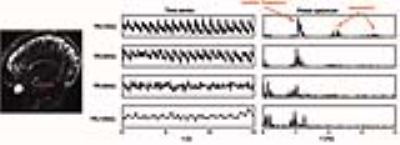 |
Cerebrovascular function in the middle cerebral artery measured using the cardiac-induced inflow effect on fast echo-planar imaging.
Joseph Whittaker, Patrick Liebig, Fabrizio Fasano, Marcello Venzi, Robin Heidemann, Kevin Murphy
We demonstrate that cardiac-induced pulsatile flow-related signal enhancement in fast EPI provides a dynamic assessment of cerebrovascular function in the brain’s large feeding arteries. We show that cardiac pulsatile waveforms, derived from magnitude data taken at the site of the middle cerebral artery, are attenuated at longer TRs, suggesting they are related to pulsatile flow rather than volume changes. The same waveforms are modulated by a global flow-increasing hypercapnic challenge, showing that this endogenous signal contrast can be useful for exploring dynamic cerebrovascular function. We propose that a multi-shot segmented EPI approach will further increase this signal contrast.
|
|
2299.
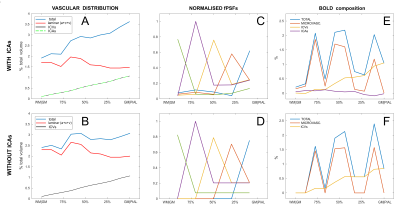 |
Modelling the laminar GRE-BOLD signal: integrating anatomical, physiological and methodological determinants
Alberto Merola, Nikolaus Weiskopf
An insight into the layered functional organization of grey matter can be offered by spatially accurate high resolution measurements of the laminar BOLD signal. However, their specificity is limited by anatomical, physiological and methodological features affecting the functional point spread function (fPSF). In order to examine these, an integrated model of the laminar GRE-BOLD signal has been formulated that combines a vascular geometric model of the cortex with a model describing the relationship between underlying physiological parameters and R2* changes. Using the new detailed model we are able to characterize the laminar GRE-BOLD signal dependency on physiological and partial volume effects.
|
|
2300.
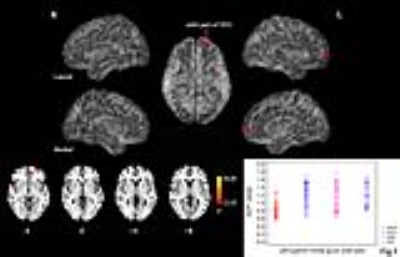 |
Sex differences in resting-state cerebral activity alterations in Internet gaming disorder
Yawen Sun, Yan Zhou, Yao Wang, Xu Han, Weina Ding, Yong Zhang, Jianxun Qu, Jianrong Xu
The purpose of this study was to explore the sex-specific neuroimaging differences involved in IGD. Thirty IGDm, 23 IGDf, 30 HCm and 22 HCf underwent rs-fMRI. ALFF and seed-based FC maps were constructed. A two-factor ANCOVA model was specified using SPM8, with sex and diagnosis as the between-subject factors. When interaction effects occurred, post-hoc pair-wise comparisons were performed using two-sample t-tests within the interaction masks. IGDm and IGDf exhibited different regional and network-level functional changes. Lower ALFF values in the orbit part of SFG showed higher impulsivity in IGDm. The results may lead to improved sex-specific treatment and prevention strategies .
|
|
2301.
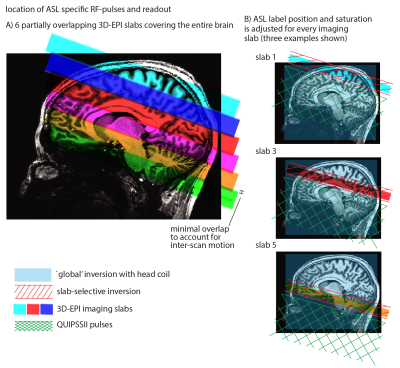 |
Human whole-brain sub-millimeter cerebral blood flow map using 7T ASL
Dimo Ivanov, Sriranga Kashyap, Roy Haast, Shanice Janssens, Laurentius Huber, Benedikt Poser, Kâmil Uludag
Arterial spin labeling (ASL) offers non-invasive cerebral blood flow (CBF) measurements, but typically suffers from low signal-to-noise ratio, limiting the achievable spatial resolution. In this work, we employ 3D EPI ASL at 7T, partially-overlapping acquisition of multiple slabs and across-session averaging to achieve a high-quality whole-brain 0.7 mm3 isotropic resolution CBF map from a healthy volunteer. The dataset presents the highest spatial resolution CBF map in humans so far, and a unique opportunity to investigate the cortical distribution of baseline CBF across and within brain areas, including providing a physiological basis for the interpretation of laminar and columnar fMRI.
|
|
2302.
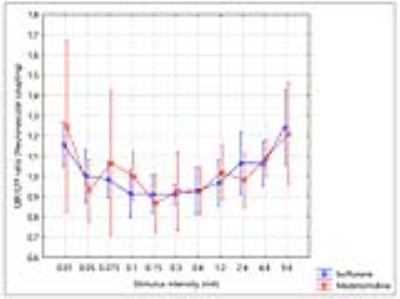 |
Comparison of neurovascular coupling and BOLD responses under medetomidine and isoflurane anesthesia in the rat somatosensory cortex.
Ryota Tokunaga, Thierry Paquette, Hugues Leblond, Tomokazu Tsurugizawa, Mathieu Piché
In this study, we aimed at comparing the coupling between neuronal activity and hemodynamic changes evoked by hindpaw stimulation, under medetomidine and isoflurane anesthesia. Simultaneous recordings of local field potentials (LFP) and cerebral blood flow (CBF) were performed in the rat somatosensory cortex. In a separate experiment, hemodynamic changes evoked by hindpaw stimulation were measured using BOLD fMRI. The coupling between LFP amplitude and CBF changes was similar between isoflurane and medetomidine anesthesia. However, BOLD signal changes were smaller under isoflurane compared with medetomidine anesthesia. This suggests that isoflurane anesthesia may alter BOLD signal through alteration of O2-consumption or O2-saturation.
|
|
2303.
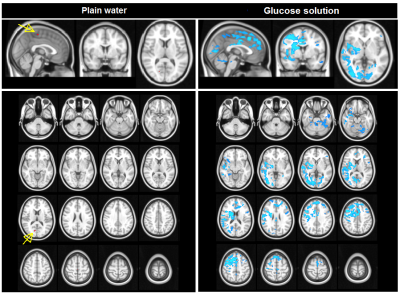 |
Brain activity and connectivity changes in response to glucose ingestion
Anna van Opstal, Anne Hafkemeijer, Annette van den Berg-Huysmans, Marco Hoeksma, Cor Blonk, Hanno Pijl, Serge Rombouts, Jeroen van der Grond
Understanding of functional brain responses yields insights into satiety signaling, nutrient sensing, energy seeking and feeding behavior. The current aim was to determine normal whole brain functional responses to the ingestion of glucose in healthy normal weight subjects using BOLD signal, network connectivity and Eigen vector centrality functional MRI analysis approaches. Our results show that ingestion of glucose in a fasted state leads to deactivation and decreased connectivity, which can be associated with satiation and reward effects in the brain and a decrease in energy seeking. In contrast, drinking plain water leads to activation and increased centrality and connectivity.
|
|
2304.
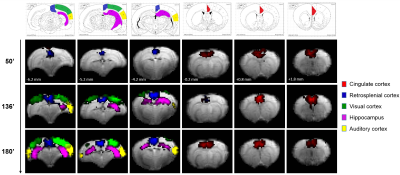 |
Anesthesia affects connectivity of default-mode sub-networks in the rat in a time-dependent and region-dependent manner
Punitkumar Makani, Rolf Gruetter, Ileana Jelescu
Anesthetic agents affect brain connectivity and/or neurovascular coupling, with confounding effects on BOLD resting-state fMRI. To date, the most widespread anesthesia protocol for fMRI in rats consists in isoflurane induction followed by medetomidine sedation. We report that, using this protocol, connectivity of default-mode sub-networks is affected in a time-dependent and region-dependent manner, with modules such as hippocampus becoming detectable as late as two hours into sedation. These spatio-temporal features have significant implications for the interpretation and comparison of resting-state studies in the rat, and of the default-mode network connectivity in particular.
|
|
2305.
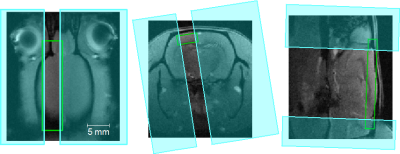 |
Cortical propagation of slow oscillation-associated traveling waves resolved by fast line scanning in brain-state-informed BOLD fMRI
Andrea Kronfeld, Felipe Aedo-Jury, Lara Hamzehpour, Albrecht Stroh
Cortical activity patterns – both spontaneous and stimulus-evoked – are significantly impacted by the respective functional brain state. Here, we explored activity patterns in two brain states: persistent state, maintained by sedation, and slow wave state, dominated by slow-oscillation-associated waves, maintained by rather deep anesthesia. Upon visual stimulation, we found localized activation of the visual cortex only in persistent state, whereas in slow wave state, large areas of the cortex are recruited. By applying fast line scanning methods, we could for the first time resolve a propagation of slow waves by fMRI, presumably evoked by visual stimulation.
|
|
2306.
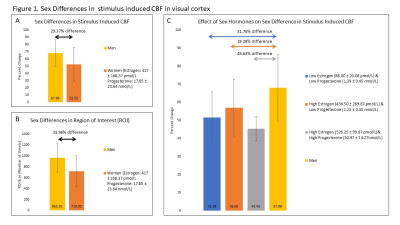 |
Sex Differences in Stimulus Induced Blood Flow: The Importance of Sex Hormones
Samantha Cote, Russell Butler, Jean-Francios Lepage, Adrianna Mendrek, Kevin Whittingstall
Sex differences in resting CBF has been reported, these differences may be explained through sex differences in sex hormones. There is currently no study that examines if this difference is maintained during stimulus-induced CBF. The current study evaluated men and naturally cycling women three times during their menstrual cycle at different sex hormone levels using a pCASL sequence. Preliminary results reveal sex differences in CBF response to the same stimulus, which is amplified when one considers sex hormones. These findings may reflect vascular effects of sex hormones, highlighting the importance of considering sex and hormone profiles when conducting fMRI
|
|
2307.
 |
Arousal-related fMRI modulations contribute to the effect of the motion-based scrubbing on local and long-range connectivity
Yameng Gu, Xiao Liu
Head motion has been shown to be associated with distinct changes in local and long-range rsfMRI connectivity, and the temporal scrubbing based on motion parameters has been proposed to remove such “motion-induced” artefacts. Here, we showed that scrubbing arousal-related time points resulted in a similar but stronger change on the rsfMRI connectivity than the motion-based scrubbing. Moreover, the effect of the motion-based scrubbing can be completely removed by retaining the part of scrubbed time points related to arousal changes. The findings suggest that arousal modulations may mediate the association between the motion and rsfMRI connectivity.
|
|
2308.
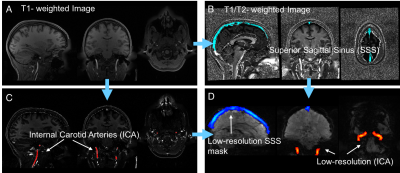 |
Robust arterial functional MRI (fMRI) data and its application
Jinxia Yao, James Wang, Xin Shen, Yunjie Tong
Previous research conducted on Myconnectome project (90 resting scan sessions of one subjects) found that systemic low frequency oscillations (sLFOs) extracted from resting-state fMRI data of big arteries to be: 1) negatively correlated with; 2) temporally leading, the fMRI data from the veins. To generalize the finding, the resting state scans from 20 randomly selected subjects of Human Connectome Project (HCP) were analyzed. The findings were validated among around 80% of the data, which also showed that cerebral circulation time between females and males are significantly different.
|
|
2309.
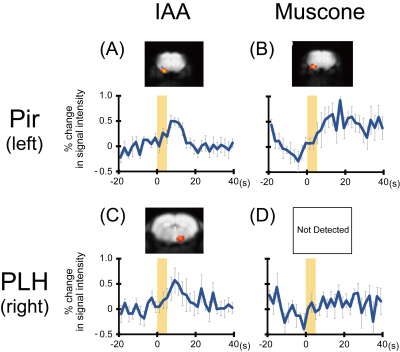 |
BOLD-fMRI comparison of olfactory responses in the mouse whole brain, with different odors and anesthesia
Fuyu Hayashi, Sosuke Yoshinaga, Naoya Yuzuriha, Mitsuhiro Takeda, Hiroaki Terasawa
Mice have well-developed olfactory systems, and the odor response throughout the mouse whole brain is an important target of olfactory research. We previously applied independent component analysis (ICA), which identifies periodically activated regions, to detect BOLD responses from odor-stimulated mice. In this study, we successfully discriminated olfactory responses from different odors, isoamyl acetate and musocone, in the mouse whole brain, using the BOLD-ICA method. In addition, we investigated the effects of urethane and medetomidine anesthetics on the olfactory responses. This study demonstrated the utility of the BOLD-ICA method to trace the real-time activation of the mouse whole brain.
|
|
2310.
 |
Vascular effect on cerebral blood flow in BOLD fMRI under fed-caffeinated effect
Ho-Ching Yang, Xin Shen, Matthew Derdak, Blaise Frederick, Yunjie Tong
In this study, we explored the vascular effect of a fed-caffeinated condition versus a fasted-uncaffeinated condition in resting-state fMRI dataset from the Myconnectome project. We extracted the low frequency oscillation signal from the superior sagittal sinus (SSS) as a vascular seed to evaluate the propagation of these signals through the brain in these two conditions.
|
|
2311.
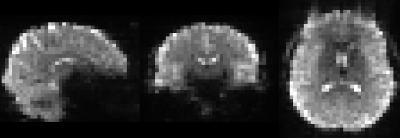 |
The footprint of physiology in ultra-fast RS-FMRI
Daniel Gomez, Zahra Fazal, José Marques, David Norris
In the current contribution we study the footprint of physiology in ultra-fast RS-FMRI timeseries by examining RSNs obtained from full brain EPI data acquired with a sampling rate of 158ms.
|
|
2312.
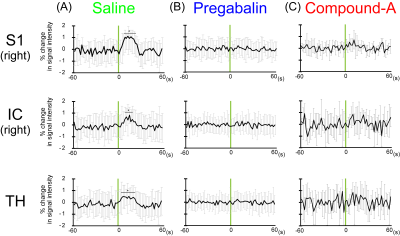 |
BOLD-fMRI evaluation of different types of analgesic agents on allodynia-specific pain in a rat chronic pain model
Mikio Sameshima, Naoya Yuzuriha, Sosuke Yoshinaga, Soichiro Ezaki, Norihito Ishida, Mitsuhiro Takeda, Yuya Terashima, Etsuko Toda, Kouji Matsushima, Hiroaki Terasawa
The aims of this study are to reveal the underlying inhibitory mechanism of a compound against the chemokine signal, based on targeted protein structures, and to evaluate the analgesic effect on allodynia-specific responses in a rat chronic pain model, with our BOLD-fMRI-based pain evaluation system using a green laser. An NMR titration analysis demonstrated that the compound strongly binds to the chemokine receptor-binding protein. BOLD-fMRI revealed that the allodynia-specific responses were suppressed by the administration of the compound, in a similar manner to the existing analgesic, pregabalin, with a completely different mechanism of action from that of the compound.
|
|
2313.
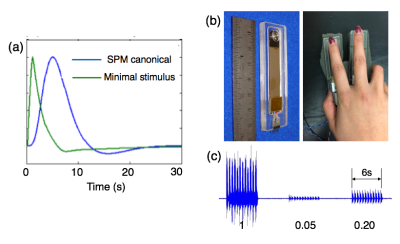 |
Evidence of faster hemodynamic response function at weak sensory stimulus levels supports higher frequency intrinsic functional connectivity
Jingyuan Chen, Gary Glover
There has been emerging evidence that resting state spontaneous neural fluctuations can persist at frequencies not supported by the canonical hemodynamic response function (HRF). As RS may likely comprise varying levels of spontaneous stimuli, it is thus of interest to query whether BOLD fluctuations elicited by small-intensity stimuli occur at faster time scales than the canonical HRF and can account for certain high-frequency (HF) phenomena observed at rest. Here, we employ a vibrotactile stimulus with graded contrasts, and show that HRFs elicited by small intensity stimuli have faster time-to-peak and narrower dispersions than canonical HRFs, thus may promise elevated BOLD responses in higher frequency bands and explain part of the HF phenomena observed in recent RS studies.
|
|
2314.
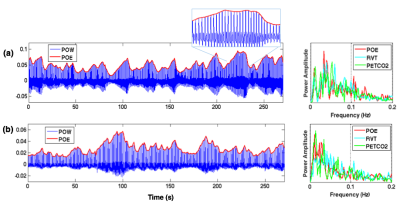 |
Interactions between cardiac waves and resting-state BOLD signals exhibit high intra-subject consistency and high inter-subject variability
Jingyuan Chen, Laura Lewis, Marta Bianciardi, Jonathan Polimeni
Low-frequency respiratory and systemic cardiovascular fluctuations can affect vascular oxygenation and manifest in the envelope of cardiac waves. Here, we examined the interaction between the envelope of cardiac waves collected by a piezoelectric (PO) sensor (POE) and fMRI signals, and found that POE may provide unique information about BOLD fluctuations that are not explained by changes of heart rate, respiratory volumes or end-tidal CO2 levels. We also observed that the interaction between fMRI, cardiac, and respiratory measures was relatively stable within individuals, but highly variable across individuals.
|
|
2315.
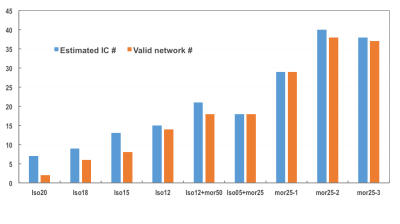 |
Functional connectivity and dynamic change of rat brain resting-state networks under morphine-induced condition
Wei Zhu, Hannes Wiesner, Xiao-Hong Zhu, Yi Zhang, Nanyin Zhang, Yunchong Ma, Wei Chen
Resting-state fMRI (rs-fMRI) in animal is essential for studying neural networks and translational research. However, animal motion poses a major obstacle for performing rs-fMRI, and it is commonly requires anesthesia that could suppress and alter the resting-state networks (RSNs). In this work, we investigated the rat RSNs under morphine condition, and the differentiation and transition of RSNs when animal conditions were changing from isoflurane to morphine. We found that the number of RSNs was significantly increased from deep anesthesia to morphine-induced condition; the RSNs became highly specific to brain functions; and thus, RSN mapping became more reliable.
|
|
2316.
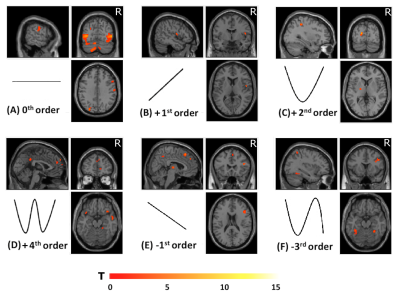 |
Force-related BOLD effects during naturalistic and symbolic effort observation
Letizia Casiraghi, Adnan Alahmadi , Anita Monteverdi, Fulvia Palesi, Gloria Castellazzi, Giovanni Savini, Karl Friston, Claudia Gandini Wheeler-Kingshott, Egidio D'Angelo
In this pilot study, we used a 3-condition fMRI squeezeball paradigm to study the non-linear BOLD response to varying grip force (GF) during action execution (AE, subjects performed the task), action observation (AO, subjects watched a video of the task) and AO with visual cue (AOvc). fMRI activity patterns in brain circuits controlling AE, AO and AOvc account for different GF applied to an object or perceived from others’ action. AO and AOvc calls different processing depending on the presence or the absence of the visual cue indicating specific regions and BOLD-GF relations for the effort perception.
|
|
2317.
 |
Bladder Filling Induced Changes to Cerebral Blood Flow and BOLD Response
Kenneth Wengler, Justina Tam, Steven Weissbart, Xiang He
Overactive bladder affects a significant portion of women in the US (~15%). Women with this syndrome experience a frequent pathologic desire to urinate with a profound impact on their quality of life and productivity. It is unclear how cerebral perfusion changes as the bladder fills. In this study eight healthy female participants were imaged with a double-echo EPI sequence for simultaneous ASL and BOLD acquisition. Bladder filling by urethral catheter was used to assess the brain’s response at filling volumes of 0, 50, 100, 200, 350 and 500mL. Increased blood flow was observed at low urgency compared to baseline while decreased blood flow was observed at high urgency compared to low urgency.
|
|
2318.
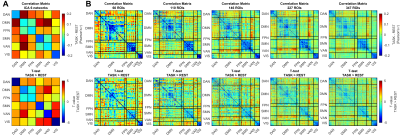 |
Multi-scale assessment of brain network response to sustained working memory task
Daniele Mascali, Silvia Tommasin, Marta Moraschi, Tommaso Gili, Ibrahim Assan, Michela Fratini, Richard Wise, Silvia Mangia, Emiliano Macaluso, Federico Giove
How low-frequency BOLD fluctuations (LFFs) are modulated when the brain is engaged in processing external stimuli is still poorly described. We exploited a non-conventional, long-lasting, block-design paradigm to study LFF modulations during sustained performance of a working memory task. Task-associated modulations were characterized by increased synchronization between networks at the expense of reduced within-network coherence. Such pattern persisted at several spatial scales, indicating a scale-invariant feature of task-associated modulations. Despite such clear-cut network behavior, no linear correlation between performance and connectivity changes was observed. Contrarily, high levels of connectivity at task and especially at rest were associated with greater performance.
|
|
2319.
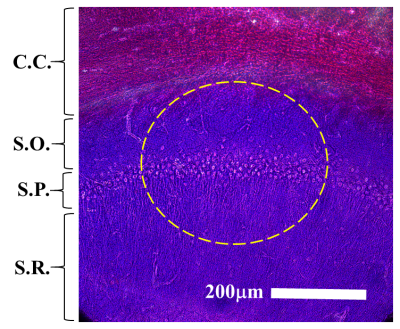 |
Investigating the Functional Diffusion-Signal Response (DfMRI) in Living, CA1 Pyramidal Neurons Undergoing Chemical Activation with Kainate
Jeremy Flint, Kannan Menon, Brian Hansen, John Forder, Stephen Blackband
In the current study, we use MR microscopy and superfusion techniques to investigate changes in the diffusion properties of living, hippocampal neurons following activation with kainate. Acute hippocampal slice preparations (n = 6) were imaged at six different b values (b = 0 to 3200 s/mm2) both before and after exposure to kainate (100mM). Significant activation-based changes (p = 0.0043) in diffusion properties were detected in the stratum pyramidale: the tissue lamina comprised primarily of pyramidal neuron cell bodies. No changes were observed in either the strata oriens (apical dendrites) or radiatum (axons).
|
|
2320.
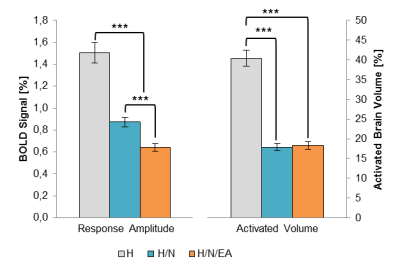 |
Characterization of the Central Analgesic Effects of Two Different Acupuncture Modalities in a Mouse Model of Nociception
Isabel Wank, Jianliang Zhang, Shuping Chen, Vanja Nagy, Liqun Zhang, Silke Kreitz, Andreas Hess, Josef Penninger
By using functional MRI, possible analgesic effects of two different acupuncture treatments (insertion of needles and electro-acupuncture) at Zusanli acupoint (ST36) were investigated. The brain’s response in anaesthetized C57Bl/6J mice to noxious stimuli with and without acupuncture was analyzed by characterization of the classical stimulus-driven BOLD parameters but also the influence on stimulus- as well as non-stimulus-driven functional connectivity-based brain networks. Acupuncture was shown to modulate (pseudo-resting state) brain networks by enhancing functional connectivity within limbic structures and decreasing thalamic connectivity particular with electro-acupuncture. Thereby acupuncture exerts control over the processing of noxious stimuli by higher-order brain regions.
|
|
2321.
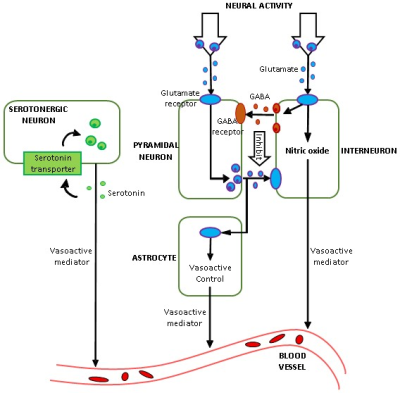 |
Approximation of 1H MRS glutamate from fMRI hemodynamic response function
Rangaprakash Deshpande, Gopikrishna Deshpande, Reza Tadayonnejad, Joseph O’Neill, Jamie Feusner
Functional MRI is a blood-based marker of neural activity. The transfer function relating the two is the hemodynamic response function (HRF), which varies across both brain regions and individuals. It is traditionally considered a confound in fMRI analysis; however, the underlying biophysics suggests that HRF might in part reflect local neurochemical substrates, specifically glutamate, GABA and serotonin. Here, we found evidence that HRF shape is associated with, and predictive of, 1H MRS glutamate in thalamus. These results open the possibility of approximating neurochemical concentrations using resting-state fMRI. Future studies could validate this in an independent and larger sample.
|
|
Task-Based fMRI: Acquisition & Analysis
Traditional Poster
fMRI
Wednesday, 20 June 2018
| Exhibition Hall 2322-2339 |
13:45 - 15:45 |
|
2322.
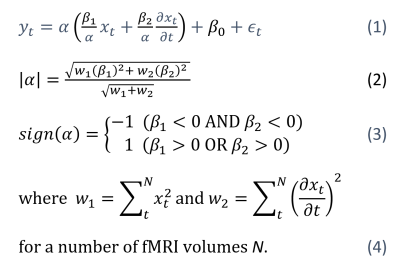 |
A Weighted Square Averaging Method of Combining Primary and Temporal Derivative Parameter Estimates In General Linear Model Analysis of Functional MRI
Kwan-Jin Jung, Hae-Min Jung
The temporal derivative has been considered as a mathematical solution for the latency variation of the hemodynamic response function (HRF) in the general linear model (GLM) analysis of the task-based functional MRI (fMRI). A method of combining the primary and derivate estimates was developed by Calhoun and its implementation was introduced. However, serious defects were revealed in the existing methods from a GLM analysis of an event-related fMRI. Here, the method is revised to provide a correct combined estimate using a weighted square average method. The proposed method was confirmed with event-related fMRI studies at various phases of the double Gamma HRF.
|
|
2323.
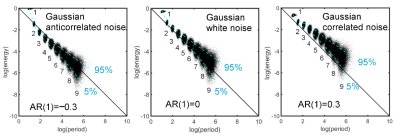 |
Energy-Period Characteristics of Brain Networks using Empirical Mode Decomposition
Dietmar Cordes, Muhammad Kaleem, Xiaowei Zhuang, Karthik Sreenivasan, Zhengshi Yang, Tim Curran, Virendra Mishra
In this project, we have studied resting-state networks using Empirical Mode Decomposition (EMD) to obtain time-frequency-energy information. Intrinsic Mode Functions (IMFs) and associated spatial maps provide a data-driven decomposition of resting-state networks. We investigated the average energy-period relationship of IMFs of group independent components analysis (ICA) networks to better characterize temporal properties of networks and found that the IMFs of BOLD data provide inverted V-shaped energy-period signatures that allow a natural ranking of all resting-state networks when compared to signatures of pure noise.
|
|
2324.
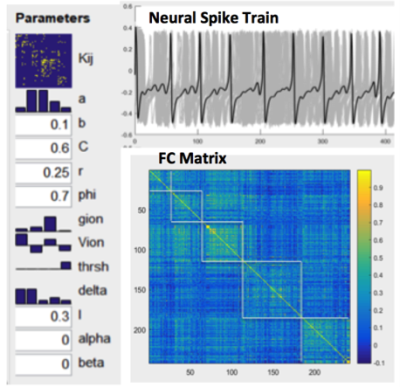 |
Neurophysiological Basis of Multi-Scale Entropy Analysis of Brain Complexity and Its Relationship with Functional Connectivity
Danny Wang, Kay Jann, Chang Fan, Yang Qiao, Yu-Feng Zang, Hanbing Lu, Yihong Yang
Recently, non-linear statistical measures such as multi-scale entropy (MSE) have been introduced as indices of the complexity of BOLD fMRI time-series across multiple time scales. In this work, we investigated the neurophysiological underpinnings of complexity (MSE) of electrophysiology and fMRI signals and their relations to functional connectivity (FC). We include both simulation data using neural mess model based brain network model and animal models with concurrent recording of fMRI and electrophysiology in conjunction with pharmacological manipulations. Our results show that the complexity of regional electrophysiology and fMRI signals is positively correlated with network FC.
|
|
2325.
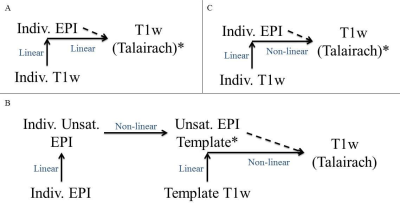 |
Registration Comparison using Unsaturated EPI vs Anatomy for Resting State Motor Network at 7T
Anna Crawford, Jian Lin, Mingyi Li, Wanyong Shin, Katherine Koenig, Mark Lowe
Taking advantage of improvements to EPI imaging at 7T could allow for direct use of EPI volumes when registering multiple volumes to a common space. We proposed using an unsaturated EPI template in order to perform the spatial co-registration of multiple subjects. In this study, we compare the quality of a resulting group map resting state motor network connectivity in order to evaluate different registration pipelines, one utilizing an EPI template as well as one based on the commonly used T1 weighted image template.
|
|
2326.
 |
Multivariate Second Level Analysis in fMRI with Canonical Correlation Analysis
Xiaowei Zhuang, Zhengshi Yang, Rajesh Nandy, Tim Curran, Dietmar Cordes
A multivariate CCA method is introduced for fMRI 2nd level analysis to incorporate local neighboring information, and to improve the sensitivity in group activation and group difference detection in noisy fMRI data. Statistical thresholds for significance of the group-inferences in the multivariate method are computed non-parametrically. Results from both simulated data and real episodic memory data indicate that a higher detection sensitivity for a fixed specificity can be achieved in both 2nd level activation and difference detection with the proposed method, as compared to the widely used univariate techniques.
|
|
2327.
 |
Quantitative assessment of fMRI head motion metrics and motion correction methods using digital motion phantoms
James Voyvodic, Pamela Romero Cruz
Head motion remains a major obstacle in fMRI. We have used realistic human digital motion phantoms with empirically-derived head movements and known BOLD signals to address two unresolved questions: 1) how effective are motion correction algorithms? and 2) how much motion is too much when assessing scan quality? Our analysis evaluated different motion metrics and motion correction methods using both block-designed and event-related fMRI task data. The results show that head motion metrics need to distinguish between positional offsets versus active movement, that combining image realignment plus motion-censoring is most effective, and that residual motion after corrections determines acceptability thresholds.
|
|
2328.
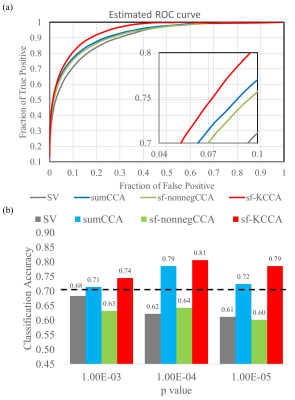 |
3D Spatially-Adaptive Canonical Correlation Analysis for Episodic Memory Task fMRI Data: Local and Global Methods
Zhengshi Yang, Xiaowei Zhuang, Karthik Sreenivasan, Virendra Mishra, Tim Curran, Richard Byrd, Rajesh Nandy, Dietmar Cordes
Spatially adaptive multivariate methods based on local CCA have been used in fMRI data analysis to improve sensitivity of activation detection. To improve specificity, local CCA methods require spatial constraints. In the past, local CCA methods have been used exclusively in 2D applications because of limitations imposed by the computational time requirements for 3D neighborhoods. We have implemented an efficient algorithm to solve the 3D local constrained CCA problem and furthermore proposed a global kernel CCA method to analyze the time series of the whole brain simultaneously. Results show that global kernel CCA outperforms local CCA in detecting activations.
|
|
2329.
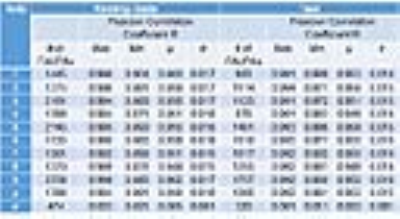 |
Human brain functional areas of unitary pooled activity identified with fMRI
Jie Huang
We define a functional area of unitary pooled activity (FAUPA) as an area in which the temporal variation of the activity is the same across the entire area, i.e., the pooled activity is a dynamically unitary activity. This unitary activity across the FAUPA implies a perfect temporal correlation for the activity-induced BOLD response, i.e., the Pearson correlation coefficient is 1 for the BOLD responses of any two locations within the FAUPA. A FAUPA may play the role of a functional unit at large-scale. We report the identification of FAUPAs for both resting-state and task fMRI.
|
|
2330.
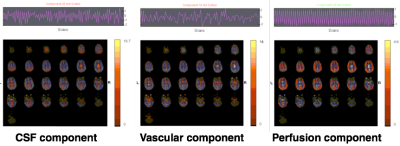 |
ICA cleanup for improved SNR in arterial spin labeling perfusion MRI
Xuetao Hao, Jan Petr, Aart Nederveen, John Wood, Danny Wang, Henk-Jan Mutsaerts, Kay Jann
We evaluate the use of Independent Component Analysis (ICA) to separate physiological and other noise from Arterial Spin Labeling (ASL) perfusion MRI as has been shown for BOLD fMRI. We show that this approach improves tSNR and cerebral blood flow (CBF) quantification in a cohort of healthy young controls and a group of children with sickle cell disease.
|
|
2331.
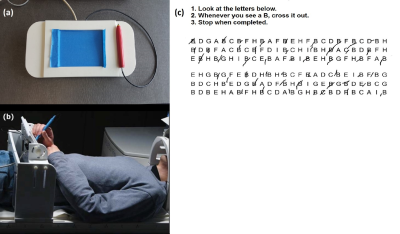 |
Functional MRI of the Letter Cancellation Test
Luke Chung, Nathan Churchill, Megan Hird, Tahira Tasneem, Fred Tam, Simon Graham, Tom Schweizer
Letter cancellation test (LCT) variants are widely used pen-and-paper assessment tools in clinical and experimental psychology, but brain regions that mediate LCT performance are not well understood. An fMRI study involving elderly healthy volunteers was conducted to establish the neural correlates of the LCT using a highly novel fMRI-compatible tablet system that enables investigation of drawing behavior. The resultant brain activation highlighted parietal and frontal regions, consistent with existing fMRI literature on visual attention. This is the first fMRI study of the LCT and the results have relevance for future clinically-oriented fMRI studies of this test.
|
|
2332.
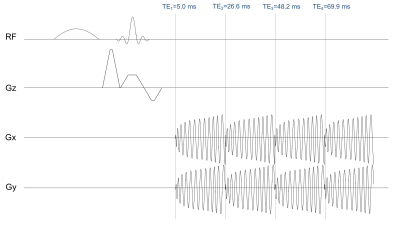 |
Cardiac-Gated 4-Echo Spiral Sequence for ME-ICA Denoising of fMRI Data
Patricia Lan, Christine Law, Gary Glover
One challenge in fMRI is separating neuronal from artifactual signal fluctuations. Recent developments in multi-echo fMRI (ME-fMRI) have enabled such classification by examining the TE-dependence of each component after ICA. However, ME-fMRI needs short readouts to fit multiple echoes before signal decay, requiring sparse sampling for EPI-sequences. Here we present our cardiac-gated 4-echo spiral sequence, which allows for short echo time and readout duration, which maximizes SNR and BOLD contrast. We were able to identify and remove T1-artifacts resulting from cardiac-gating’s variable-TR, an essential aspect for applications such as spinal cord fMRI, where cardiac-gating is required to remove CSF pulsation effects.
|
|
2333.
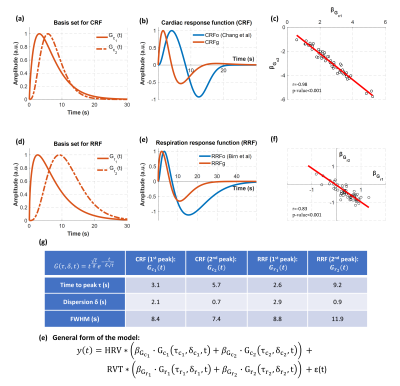 |
Exploiting the physiological properties of the global signal to correct for fluctuations in BOLD fMRI induced by heart rate and respiratory variations
Michalis Kassinopoulos, Georgios Mitsis
Functional connectivity (FC) in fMRI has generated major attention recently. Patterns of FC are consistently found in healthy subjects, whereas alterations of these patterns have been associated with many neuropsychiatric disorders. However, confounding factors arising from physiological processes have to be taken into consideration when analyzing and interpreting the results in order to ensure their validity. Even though physiological noise correction is commonly applied to fMRI, it is believed that the field would certainly benefit from more efficient techniques. In this study, we examine the relationship of the global BOLD signal with fluctuations in heart rate and respiration and propose a new method for removing the associated artifacts from whole-brain fMRI data.
|
|
2334.
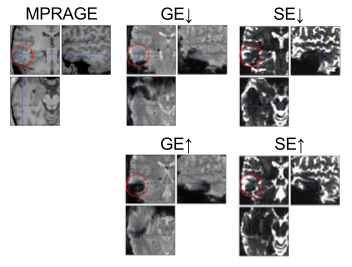 |
Susceptibility distortion correction for fMRI
Gina Joue, Tobias Sommer, Siawoosh Mohammadi
Multiband echo planar imaging (EPI) offers increased temporospatial resolution and statistical power for functional magnetic resonance imaging (fMRI) but the higher spatial resolution comes at the cost of higher susceptibility-related spatial distortions. In diffusion MRI (dMRI), studies have shown that distortion correction is better when using blip-reversed EPI data (known under the term blip-up/down images) as compared to the standard fieldmap approach. This has motivated fMRI studies to acquire their data with blip-up/down directions and to use these to reduce susceptibility distortion. Here, we qualitatively illustrate why this can lead to erroneous results and quantify this error across 10 subjects.
|
|
2335.
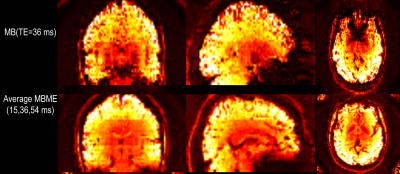 |
Comparison of MB and MBME in task fMRI
Zahra Fazal, Daniel Gomez, Jos??????é Marques, Benedikt A Poser, David G Norris
In this work a multiband protocol is compared to a Multiband Multi-echo (MBME) protocol in the context of task fMRI at 3T. Furthermore, we evaluate the use of FSL- FIX to clean both datasets and compare its impact on the acquisition protocols in terms of tSNR, sensitivity and statistical significance.
|
|
2336.
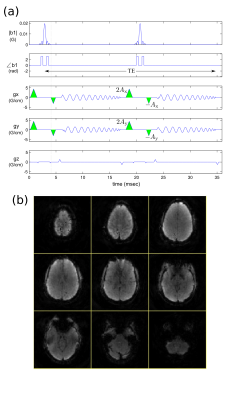 |
The case for 3D PRESTO fMRI: Improved temporal SNR via ghost suppression by temporal filtering
Jon-Fredrik Nielsen, Tianrui Luo, Scott Peltier, Douglas Noll
We apply a recently-introduced method for more efficient RF-spoiling in dynamic imaging to PRESTO fMRI, and show that this improves temporal SNR significantly. For a whole-brain fMRI acquisition with high temporal resolution (TRvol=0.52s) and 3.3mm isotropic resolution, tSNR is maximized for a net gradient area of only about 1-1.5 cycles/voxel (applied to two gradient axes). We anticipate that the use of such low spoiler gradients will make PRESTO a much more viable alternative for 3D fMRI.
|
|
2337.
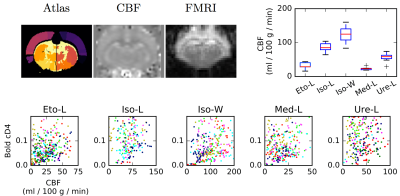 |
Impact of cerebral blood flow level on the fluctuations of resting-state BOLD fMRI in anesthetized rats
Sophie Achard, Guillaume Becq, Tarik Habet, Nora Collomb, Margaux Faucher, Chantal Delon-Martin, Véronique Coizet, Emmanuel Barbier
The Blood Oxygen Level Dependent (BOLD) signal, used in resting-state functional Magnetic Resonance Imaging (fMRI), is tighly linked to Cerebral Blood Flow (CBF). This study evaluates the impact of the CBF on the low-frequencies BOLD fluctuations and four physiological parameters during restingstate in 5 groups of rats (Wistar and Long-Evans) anesthetized with Isoflurane, Medetomidine, Etomidate and Urethane. It is shown that the CBF is not related to physiological parameters, and there exists a range of CBF values where the BOLD fluctations are sufficiently high for being used in any other analysis.
|
|
2338.
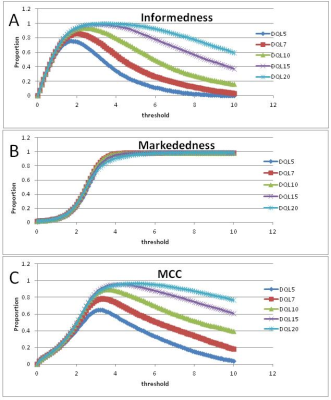 |
Can measures for evaluating gambling strategies inform decisions about fMRI pipelines?
David McAllindon, Steve Patterson, Chris Bowen, Christopher O'Grady, Jeff Kowalski, Steven Beyea
In single-subject fMRI such as is used in presurgical mapping, processing decisions and choice of threshold can greatly affect the activation maps. In order to provide support for making these decisions, we propose a self-similarity approach that uses comparisons across randomly-created split-halves of the data and evaluating the maps using measures that come from a gambling model - the Bookmaker Informedness, Markedness and Matthews Correlation Coefficient - using an fMRI simulation. Early results indicate that features of Informedness and Matthews Correlation Coefficient data may be useful for making pipeline and threshold decisions.
|
|
2339.
 |
Mapping drug resistant epilepsy with MREG signal coefficient of variance.
Janne Kananen, Timo Tuovinen, Hanna Ansakorpi, Heta Helakari, Niko Huotari, Ville Raatikainen, Aleksi Rasila, Lauri Raitamaa, Viola Borchardt, Vesa Korhonen, Vesa Kiviniemi
In the absence of detectable epileptiform activity, even combined EEG-fMRI scanning may fail to detect the epileptic foci. We utilize a novel measure of BOLD signal stability, the coefficient of variance (CV), with ultra-fast fMRI sequence MREG in drug resistant epilepsy (DRE). We detect a robust increase of MREG CV in patients with in white matter, brainstem and cerebellum in DRE at group level. Importantly, thresholding the CV +3 std above mean enables individual level mapping of epileptic abnormality in DRE patients.
|
|
fMRI: Basic Neuroscience
Traditional Poster
fMRI
Wednesday, 20 June 2018
| Exhibition Hall 2340-2376 |
13:45 - 15:45 |
|
2340.
 |
Resting-state fMRI reveals altered auditory and pain perception networks in patients with inflammatory bowel disease (IBD)
Faranak Heidari, Gilaad Kaplan, Mark Swain, Bradley Goodyear
Inflammatory bowel disease (IBD) is a chronic and painful inflammatory-mediated disease of the gastrointestinal system. Recent animal model evidence suggests that cognitive deficits and mood changes experienced by IBD patients are not merely emotional reactions, but result from structural and functional changes in the brain. We used dual-regression analysis of resting-state fMRI data to identify alterations in functional connectivity in IBD patients compared to controls. Connectivity was altered with auditory and pain perception networks, which may help explain behavioural symptoms (hearing loss, pain) commonly experienced by IBD patients.
|
|
2341.
 |
Brain functional connectivity signatures of neuropathic pain-induced depression in a preclinical model
Meltem Karatas, Muris Humo, Laetitia Degiorgis, Marion Sourty , Thomas Bienert, Céline Meillier, Jean-Paul Armspach, Dominik von Elverfeldt, Ipek Yalcin, Laura-Adela Harsan
Chronic pain disorders are associated with high prevalence of depression which points to a link between two pathologies; although the underlying mechanisms remain elusive. As a translational approach, preclinical MR imaging offers a unique opportunity to reliably establish causal relations between the pathological conditions and brain function in vivo. In this study, we used a mouse model of neuropathic pain to investigate affective consequences of chronic pain. We performed behavioural assessments as well as resting-state fMRI and our results show a remodelling of functional connectivity in regions belonging to default-mode network and the reward system in mice with pain-induced depression.
|
|
2342.
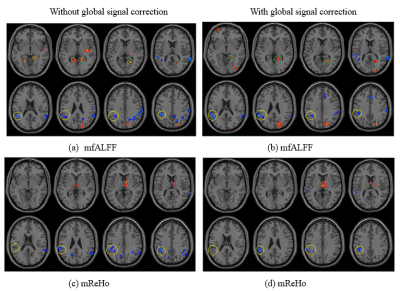 |
Research on the brain function of cervicogenic vertigo: A resting-state fMRI study
Kuang Cuili, Fan Yang
People with cervicogenic vertigo(CV) due to vertebrobasilar insufficiency suffer lots of troubles. Through neuroimaging analysis method, this study finds significant difference in right cerebellum anterior lobe(RCAL) on mfALFF value and connectivities with other brain regions between CV and normal control(NC). Besides, the mfALFF and mReHo of RCAL are correlated to DHI(Dizziness Handicap Inventory) significant positively. These discoveries seem to indicate that a long-term vertebrobasilar insufficiency results in such alterations of these functional indexes and connectivities in RCAL of CV, then lead to the function degradation of maintain the basic balance of the body when occurrence of vertigo.
|
|
2343.
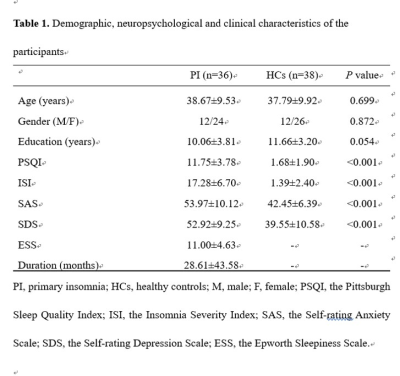 |
Hot-wiring of functional brain connectome in neurologically asymptomatic patients with primary insomnia
Xiaofen Ma, Guihua Jiang, Queenie Chan, Zhizheng Zhuo, Jin Fang, Shishun Fu, Guang Xu, Wenfeng Zhan
Functional and structural neuroimaging studies have revealed abnormal of Primary Insomnia (PI) patient's brain, including decreased gray matter density, and increase of spontaneous brain activity and metabolism in hippocampus and fronto-parietal cortex, and so on. We use graph-based approaches to investigate the topological abnormalities of functional brain networks in PI patients and examine clinical correlates of the alterations. PI patients exhibited increased overall connectivity of functional brain networks and nodal efficiency in the default mode network (DMN) and emotional circuit. This abnormal organization of large-scale functional brain networks in PI, which could account for memory and emotion dysfunction in PI patients.
|
|
2344.
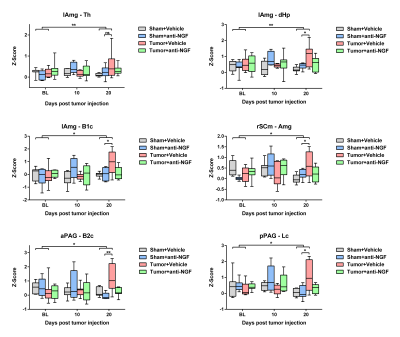 |
Preventive anti-NGF treatment suppresses alterations in functional connectivity imposed by cancer-induced bone pain in mice
David Buehlmann, Giovanna Ielacqua, Jael Xandry, Markus Rudin
The efficacy of an anti-nerve growth factor (NGF) antibody in preventing rearrangements of whole-brain functional connectivity elicited by nociceptive input following bone metastases was evaluated in a mouse model of cancer-induced bone pain using longitudinal resting-state fMRI. ROI-based network and seed-based connectivity analysis approaches revealed major hubs of ascending and descending pain pathways to be affected by the developing pain. Functional rearrangements within these regions could be prevented by prospective application of anti-NGF antibody mAb911 indicating the efficacy of anti-NGF treatment in preventing, or at least delaying, adaptations of the brain circuitry associated with development of a chronic pain state.
|
|
2345.
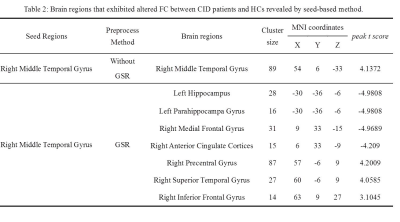 |
Altered Voxel-based Functional Connectivity Density of Default Mode Network in Chronic Insomnia: A resting-state fMRI study
Zhonglin Li, Enfeng Wang, Tianyi Qian, Zhi Zou, Thomas Beck, Yanrui Shen, Xiaolin Wu, Shewei Dou, Dapeng Shi, Meiyun Wang, Hongju Zhang, Yongli Li
This study aimed to investigate the potentially altered functional connectivity (FC) of the default-mode network (DMN) in chronic insomnia disorder (CID) patients. A voxel-based functional connectivity density (FCD) analysis method was applied to identify abnormal FC among 44 CID patients and 31 healthy controls. A seed-based FC analysis and independent component analysis were also employed and compared. CID patients showed increased FCD in the right medial temporal gyrus (MTG), including long and short distance connections. Our results suggest that hyperarousal of the DMN may be related to increased FCD of the right MTG. Furthermore, the altered connectivity within or outside the DMN may further contribute to cognitive, emotional, and memory impairment.
|
|
2346.
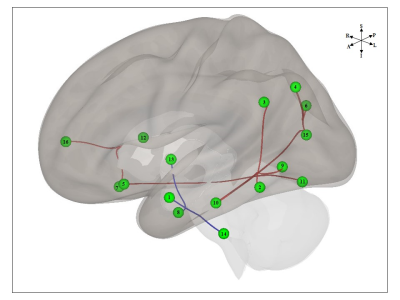 |
Asymmetric Functional Connectivity in Major Depressive Disorder Revealed by Ultra-high Field Resting-state fMRI
Chan-A Park, Enae Cheong, Youngkyu Song, Sungho Tak, Gyunggoo Cho, Jin-Hun Sohn, Chaejoon Cheong
The purpose of the study is that the investigation of resting-state functional magnetic resonance imaging (MRI) with 7T MRI via seed-based correlation analysis is examined the significant difference of the whole-brain functional connectivity among major depressive disorder (MDD) patients and healthy subjects. The results showed that MDD had higher correlations compared with healthy group. Furthermore, MDD exhibited lateralization of connected regions, including the lateral occipital cortex, inferior temporal gyrus, angular gyrus, temporal fusiform cortex, occipital fusiform gyrus, and lingual gyrus, mainly located in the left hemisphere. These suggest that MDD is associated with disruptions in the asymmetric organization of brain.
|
|
2347.
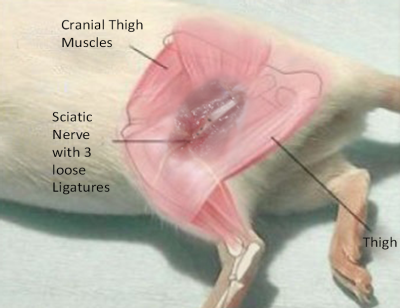 |
Changes in Brain Function induced by Chronic Neuropathic Pain in a Mouse Model of Chronic Nerve Constriction Injury
Katja Sauer, Isabel Wank, Silke Kreitz, Andreas Hess
The aim of this study was to investigate the effects of the well-established chronic constriction injury (CCI) model on central nociceptive processing in mice over a period of 56 days. For this purpose two behavioral tests (Hargreaves and electronic pressure-meter test [“plantar test”]) and functional MRI were combined. The ligation of the sciatic nerve induced behavioral changes indicative of a neuropathic pain state. Graph theoretical analysis of functional connectivity revealed known effects of chronic pain for the first time also for the CCI model: modifications of the sensory as well as emotional system induced by thermal but also mechanical stimulation.
|
|
2348.
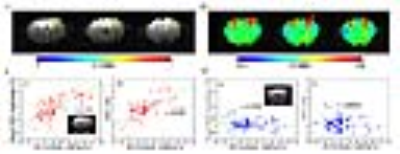 |
Resting-state fMRI predicts somatosensory-evoked BOLD fMRI in anesthetized mice
Hyun-Ji Shim, Won Beom Jung, Sangwoo Kim, Seong-Gi Kim
BOLD fMRI in rodents has been used to investigate brain functions in normal and diseased conditions. Until now, most animal fMRI have used anesthetics to reduce animal stress and minimize motions. Because anesthesia affects neurovascular coupling, maintaining the proper physiological condition under anesthesia is important. However, it is challenging in mice due to the limitation of physiological monitoring and high sensitivity to anesthetics used. Here we introduced ketamine and xylazine anesthesia in mice. Then, to examine the variability of fMRI response and indirectly measure the physiological condition, we use the resting state fMRI (RS-fMRI), which detects intrinsic brain state and connectivity.
|
|
2349.
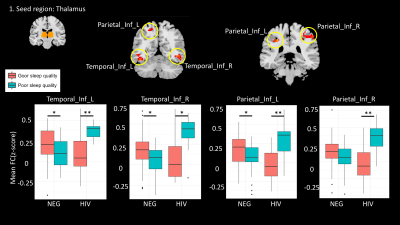 |
Sleep Quality and Its Impact on Functional Connectivity and Cognitive Performance in HIV Infected Individuals
Yuchuan Zhuang, Lu Wang, Madalina Tivarus , Xing Qiu, Michael Yurcheshen, Jianhui Zhong, Giovanni Schifitto
We investigated sleep quality in HIV infected individuals and its potential impact on cognitive performance and functional connectivity. Sleep quality was assessed using a self-report questionnaire, Pittsburgh Sleep Quality Index (PSQI). Cognitive performance was measured by a standard battery of neuropsychological tests assessing six cognitive domains, while functional connectivity was assessed by resting-state fMRI. We used a seed-based method to investigate the activation changes associated with the thalamus and frontoparietal network. We found a strong interaction between HIV infection and sleep quality, in the inferior temporal gyrus and the inferior parietal lobule but no deleterious effect on cognitive performance.
|
|
2350.
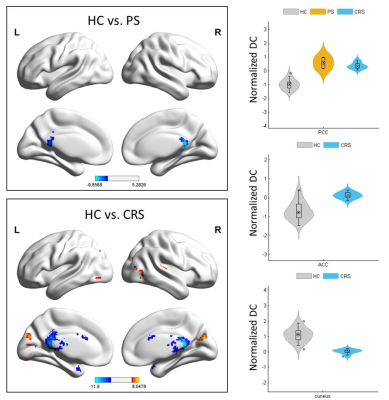 |
Alterations of neural activity patterns in pontine versus coronal radiata stroke
Chunxiang Jiang, Siqi Cai, Rui Meng, Xiaojing Long, Hang Zhang, Lijuan Zhang*
We compared the alteration of intrinsic neural functional networks in 15 patients with ischemic stroke (IS) in pontine (PS) and 21 patients with IS in coronal radiata (CRS) with 30 healthy controls (HCs). Degree centrality (DC) increased in posterior cingulate gyrus and ReHo decreased in sensorimotor cortex and default mode network in PS and CRS group relative to HCs group. DC increase was observed in cuneus in CRS group. These findings suggest that IS disrupts the functional integration of brain in an extensive scale, and the lesion location may substrate the functional outcomes for the IS patients.
|
|
2351.
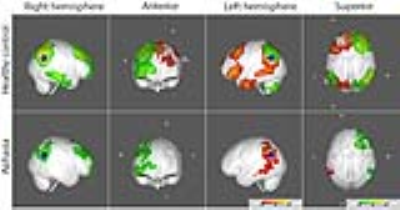 |
Diaschisis of The Language Network in Resting State fMRI Functional Connectivity of Post-Stroke Chronic Aphasia
Kwan-Jin Jung, Jacquie Kurland
Functional connectivity (FC) of intrinsic networks was compared between two groups: healthy controls and post-stroke aphasia, using resting state fMRI. While the FC of auditory, motor, and default mode networks were preserved, FC of the language network was disrupted in the aphasia group. The aphasia group showed left ipsilateral frontal FC from the Broca area but not from the Wernicke area. Similarly, the aphasia group showed left ipsilateral temporo-parietal FC from the Wernicke area but not from the Broca area. Thus, a clear picture of diaschisis, not just structural disruption, was revealed in the FC of the aphasia group.
|
|
2352.
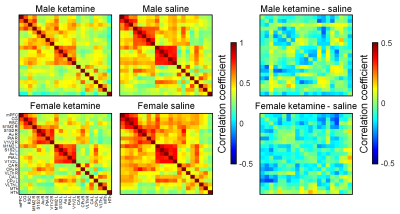 |
Ketamine-induced modulation of functional connectivity in male and female rats
Jaakko Paasonen, Leena Penna, Tomi Rantamäki, Olli Gröhn
To get further insights into sustained and gender-dependent neurobiological effects of ketamine, an N-methyl-D-aspartate blocker carrying antidepressant and addictive properties, we investigated the resting-state functional connectivity (FC) in female and male rats 24 hours after a subanesthetic dose of ketamine. Ketamine tended to suppress FC between several brain regions such as hippocampus - medial prefrontal cortex and caudate putamen - medial prefrontal cortex. Significant interactions between treatment and gender were also observed. These observations shed light on the mechanisms underlying the complex neurobiological effects produced by ketamine.
|
|
2353.
 |
Functional connectivity underlying attentional deficits in children born preterm
Trevor Flynn, Olga Tymofiyeva, Dawn Gano, Donna M Ferriero, A James Barkovich, Duan Xu
Children born very preterm are at a increased risk to develop attention deficits. Here we employ fMRI connectivity analysis to study the functional connectivity underlying these attention deficits in preterm children ages 10-14. Subjects were separated into normal and attention deficit groups and then group differences in voxelwise connectivity from 16 seed regions were delineated using AFNI. Significant clusters of hypoconnectivity in the attention deficit group were found in eight of the ROIs, primarily from the middle frontal gyri and anterior cingulate cortices, as well as hyperconnectivity from the right anterior insula.
|
|
2354.
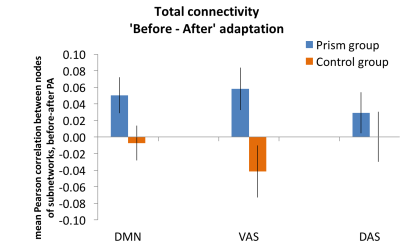 |
Changes in functional connectivity in the ventral attention system
Louis Gudmundsson , Jakub Vohryzek, Eleonora Fornari, Stephanie Clarke, Patric Hagmann, Sonia Crottaz-Herbette
Prismatic adaptation (PA), a therapy for neglect after a stroke, showed conflicting results in the literature. The variability of brain lesions leading to neglect and their relation to structures affected by PA could explain those results. MRI studies found focal brain activations after PA. We aim to understand if there is an effect on functional networks after PA. To do so, we analyzed the resting state fMRI connectivity of healthy subjects before and after PA. We found that the ventral attention system (VAS) was less connected after PA, this provides new insights to select patients for this therapy.
|
|
2355.
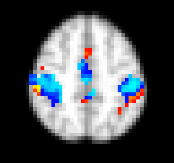 |
Mirror Therapy Increases Resting-State Functional Connectivity in Stroke Recovery
Christine Law, Aarti Sharma, Iris Grunwald
Mirror therapy increases resting-state functional connectivity when compared to conventional rehabilitation. In particular, connectivity increase is linearly proportional to increase in pinch strength. Our results strongly indicate neuronal changes resulting from mirror therapy, and that mirror therapy is of palpable benefit.
|
|
2356.
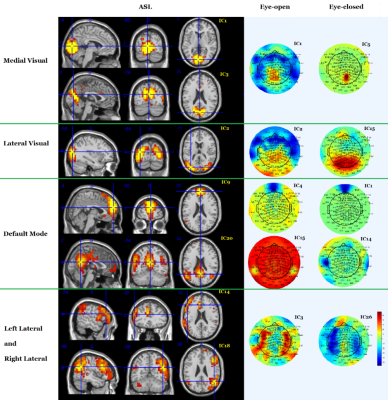 |
Comparison of Resting State Networks using EEG and Pseudo-continuous ASL
Wenna Duan, Wen-Ming Luh, Mingzhao Chen, Weiying Dai
Arterial spin labeling (ASL) and electroencephalography (EEG) data were acquired separately on young healthy subjects to verify whether EEG signal reflects the same brain networks corresponding to those extracted from ASL images. Four brain networks were derived from both resting state ASL images and resting state EEG recordings during both eye-open and eye-closed conditions.
|
|
2357.
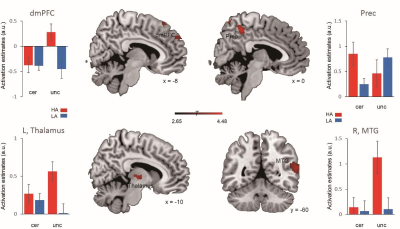 |
Altered brain activation and connectivity during anticipation of uncertain threat in anxiety
Haiyang Geng, Ruolei Gu, Xuebing Li
In the present study, we used an emotional anticipation paradigm with functional magnetic resonance imaging (fMRI) to examine the anticipation processing of uncertain threat in anxious individuals by employing brain activation and general psychophysiological interactions (gPPI) analysis. Our findings show altered activations in dmPFC, precuneus, thalamus, and MTG; impaired connections of dmPFC-vmPFC, precuneus-FPN, precuneus-MTG, and precuneus-PHA during anticipation of uncertain threat in anxious individuals, which may be involved in estimation of, perception of, and emotional reactions to uncertain threat. All of these altered neural patterns may together contribute to pathology of anxiety. Our study also provides a new insight for neural and behavioral treatments focusing on the dmPFC-vmPFC circuit that underlies uncertainty estimation and emotion regulation in anxiety-related disorders.
|
|
2358.
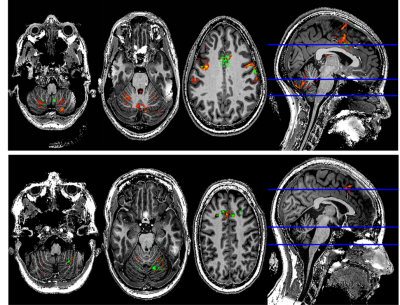 |
BOLD responses in the posterior cerebellum differ when a motor task has a proprioception component
Wietske van der Zwaag
The cerebellum receives proprioceptive information from the body, as well as tactile input. Here, we aimed to separate the proprioceptive BOLD responses from the motor/somatosensory clusters in the human cerebellum. Regions responding to a fingertapping task and a motion task requiring proprioceptive information were found to differ in the posterior cerebellum. Using high resolution 7T functional MRI, all proprioceptive clusters in lobule VIII of the cerebellum were found to be positioned medial to regions responding to the simple tapping task.
|
|
2359.
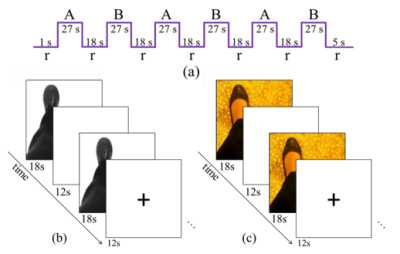 |
Novel functional MRI study reveals cognitive deficits in diabetic peripheral neuropathy
Fangrong Zong, Abdalla Mohamed, Caroline Wong, Michelle Wong, Kavita Venkataraman, Fatima Nasrallah
Paradigm design in the functional MRI acquisition is of paramount importance to investigate brain activities non-invasively. This is the first time to introduce imagination tasks of walking on floors with different surface stiffness in studying the consequence of a disease associated with diabetic peripheral neuropathy. Our results from the study-specific paradigms show a strong involvement of central nervous system in diabetic peripheral neuropathy subjects as well as cognitive deficits in sensation as caused by the disease.
|
|
2360.
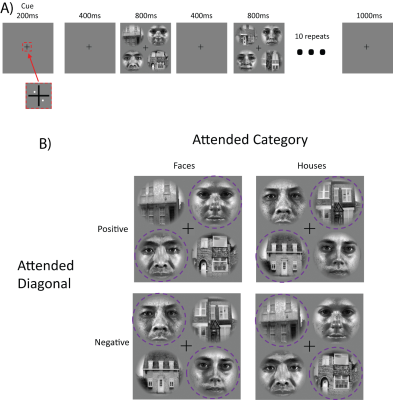 |
Spatial- and category-based attention have distinct functional organizations in human visual cortex
Pei Huang, Marta Correia, Justin Gardner, Johan Carlin
Recent studies have challenged the two-streams division of primate visual cortex into a ventral object identity stream (‘what’) and a dorsal object location stream (‘where’). We collected fMRI data while human participants performed a selective attention task. We used a multivariate discriminant method to separately decode the currently attended location and object category. We found a distinction between early visual regions coding the attended location and ventral/dorsal stream regions coding the attended category. Our study reveals a large-scale functional organization for spatial- and category-based attention in visual cortex, but its principal axis is posterior-anterior rather than dorsal-ventral.
|
|
2361.
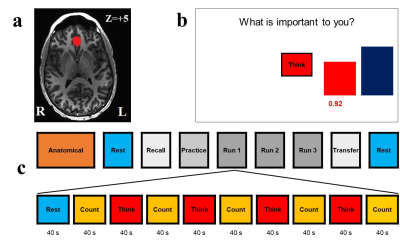 |
Title: Self-Regulation of vmPFC Activation Using Real-Time fMRI Neurofeedback
Ahmad Mayeli, Vadim Zotev, Raquel Phillips, Hazem Refai, Martin Paulus, Jerzy Bodurka
In this study, we have examined the feasibility of training healthy human subjects to self-regulate the hemodynamic activity of the vmPFC using real-time fMRI neurofeedback (rtfMRI-nf). Eight healthy subjects took part in experimental group with real rtfMRI neurofeedback from vmPFC and four in control group with a sham feedback from HIPS region. The results show significant vmPFC BOLD activity differences between the groups, demonstrating the feasibility of targeted modulation of the vmPFC using the rtfMRI-nf.
|
|
2362.
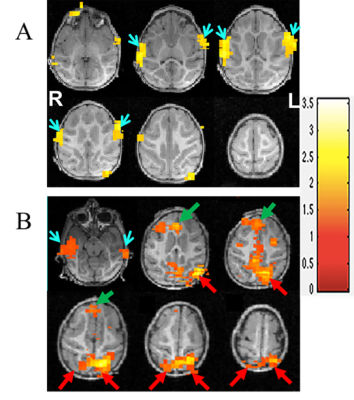 |
Visual cortex and auditory cortex activation in early binocularly blind macaques: A BOLD-fMRI study using auditory stimuli
Lingjie Wu, Rong Wang, Zuohua Tang, Xinghuai Sun, Xiaoyuan Feng, Weijun Tang, Wen Qian, Jie Wang, Yufeng Zhong, Zebin Xiao, Zhongshuai Zhang
We aimed to detect the changes in BOLD activity between the visual and auditory cortices of monocularly blind neonatal macaques by using pure tones as auditory stimuli. The changes in the BOLD response in the bilateral visual and auditory cortices were detected and further compared with the findings of the immunofluorescent staining. In monocularly bind macaques, we found a greater level of significant activation in the bilateral visual cortices while the number of activated volumes of the bilateral auditory cortices decreased. Therefore, cross-modal plasticity within the visual and auditory cortices was established in the monocularly blind macaques.
|
|
2363.
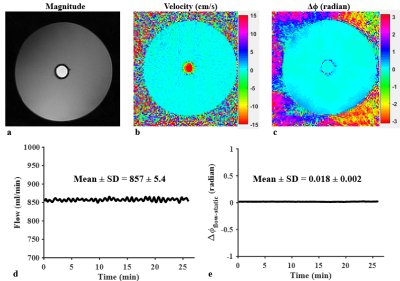 |
CMRO2 Changes During Sleep in Humans
Hyunyeol Lee, Erin Englund, Ana Rodriguez-Soto, John Detre, Richard Schwab, Felix Wehrli
Synaptic transmission is well known to be reduced during sleep, and yet very little is known about the extent to which the various stages of sleep affect neurometabolism. Here, we measured whole-brain CMRO2 in test subjects by means of the OxFlow technique while collecting data continuously for a period of 30 minutes, first during wakefulness and, in a second set of experiments, during sleep and subsequent arousal. During wakefulness CMRO2 was stable (average CV~7%). Following onset of sleep there was a rapid decrease in CMRO2 by up to 25%, along with increased SvO2 but almost unaltered CBF.
|
|
2364.
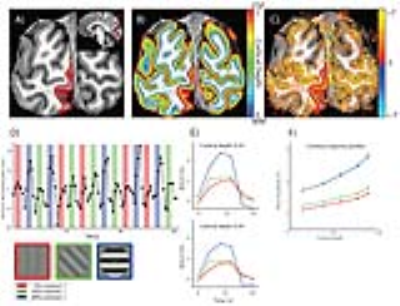 |
Linear systems analysis of laminar sub-millimetre GE-EPI fMRI
Jelle van Dijk, Alessio Fracasso, Serge Dumoulin
Nearly all fMRI analysis methods assume a linear relationship between local neuronal activity and the BOLD signal. This assumption is supported for fMRI at conventional resolutions (>1 mm isotropic). We assess whether linearity of the BOLD signal holds at sub-millimetre resolution, over cortical depth. We acquired functional GE 3D-EPI data at 0.7 mm isotropic resolution (TR/TE = 57/28 ms). Stimuli consisted of moving circular sine gratings at 80%, 20%, and 5% contrast. Our results suggest that response profiles for one contrast are linearly scaled response profiles of any other contrast.
|
|
2365.
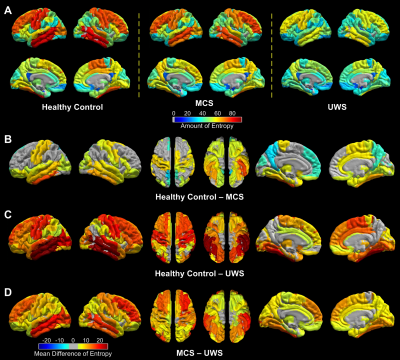 |
Information content carried by resting-state BOLD fMRI signals reduces differentially in sensory and memory compared with cognitive systems in MCS and UWS patients
Xiaolin Liu, Xinhuai Wu, Shanshan Chen, Lubin Wang, Bing Wu, Yituo Wang, Mingmei Ge, Zhan Xu, B. Douglas Ward, Shi-Jiang Li, Zheng Yang
How brain injuries affect the information content carried by signals of brain imaging modalities in patients with consciousness disorders has received little attention. We proposed a novel principal-components-analysis-based approach to quantify regional information content in patients in a minimally conscious state (MCS) and with unresponsive wakefulness syndrome (UWS). We show a reduction of regional information content in both patient populations. Importantly, our analyses revealed differential patterns in the reduction of information content in the sensory and memory compared with high-order cognitive systems in MCS and UWS; such observations are consistent with the clinical symptoms in the two DOC patient populations.
|
|
2366.
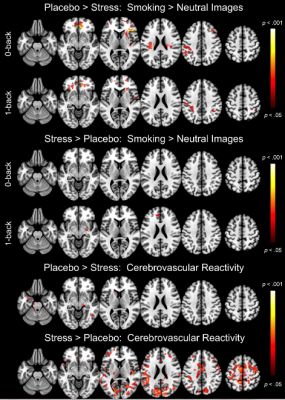 |
Acute stress modulates cigarette cue-evoked neural activation: A neuropharmacological investigation among non-treatment-seeking cigarette smokers
Eric Woodcock, Vaibhav Diwadkar, Jeffrey Stanley, Dalal Khatib, Mark Greenwald
Separately, acute stress and cigarette cues are associated with cigarette smoking relapse, and each has been shown to increase nicotine seeking/self-administration. However, their potentially additive effects are understudied in humans. Using functional neuroimaging and a placebo-controlled double-blind design, we found acute stress suppressed cue-evoked activation in the medial orbitofrontal, parietal, and prefrontal cortices. Further, the effects of stress on nicotine withdrawal severity were inversely related to medial orbitofrontal and nucleus accumbens activation. Our findings illustrate acute stress exerts cooperative modulation of neural signals and subjective withdrawal severity, known to be important for long-term abstinence.
|
|
2367.
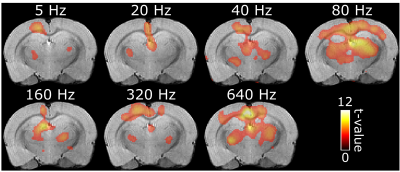 |
Brain fMRI responses during spinal cord stimulation in rats
Lauri Lehto, Hanne Laakso, Carlos Cuellar, Igor Lavrov, Silvia Mangia, Shalom Michaeli
Spinal cord stimulation (SCS) has had success in pain management and promising results were demonstrated in other pathologies. To our knowledge, no preclinical studies of SCS in combination with brain fMRI exist, which limit exploration of novel SCS strategies. Here, we show our first results of simultaneous SCS and brain fMRI in rats aiming to establish a framework for future SCS developments. Stimulating spinal cord segment L2 induced a BOLD activation in the primary somatosensory/motor cortex and the thalamus that was dependent on the stimulation frequency. These results demonstrate that monitoring modulation of brain activity due to SCS is feasible.
|
|
2368.
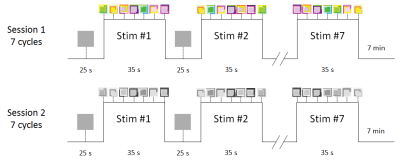 |
Piriform cortex involvement in odor imagery
Jérémy Weber, Muriel Jacquot, Faustine Noël, Jacques Felblinger, Gabriela Hossu
Current research relies on the piriform cortex as an indicator of successful odor imagery. Using colored arrangements as visual stimulation, we seek to show that the piriform cortex is mainly linked to odor perception. Our results support this hypothesis by showing a clear lack of activation in this area during odor imagery. Furthermore this study definitively highlights the use of colored arrangements in an odor imagery study compared to other visual stimulation and its benefits.
|
|
2369.
 |
Assessing cue-induced brain response in heroin-dependents treated by methadone maintenance and protracted abstinence measures
Xuan Wei, Jiajie Chen, Qiang Li, Wei Li, Wei Wang
Our research aimed to compare PA with MMT,to reveal which abstinence way is better to recover the brain function in heroin-dependent individuals.24 heroin-dependent patients under PA ,19 heroin-dependent patients under MMT and 20 healthy volunteers were recruited. The functional images were acquired by using a spin-echo EPI. In the last part of this study, we proved PA group is closer to healthy group.This study showed that PA is more advantageous than MMT to reduce heroin addiction in drug cue-reactivity.
|
|
2370.
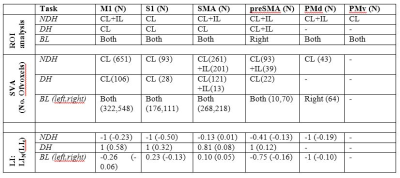 |
BOLD activation pattern of dominant versus non-dominant hand wrist extension task in stroke patients and healthy subjects
Dixit Sharma , Neha Singh , Megha Saini , Sneh Anand , Nand Kumar , MV Padma Srivastava , S Senthil Kumaran , Amit Mehndiratta
Flexor-hypertonia being the most common symptom of stroke, overcoming it by attaining wrist-extension can be judged as key function of recovery of stroke. We compared activation pattern of dominant versus non-dominant hand movements of wrist-extension of 6 healthy-subjects with 6 dominant and 6 non-dominant stroke using fMRI. Results in healthy-subjects show differences in activation-pattern of dominant and non-dominant hand. Stroke patient’s results shows ipsilesional activation-pattern with dominant-hemisphere stroke with activation in motor, sensory area and cerebellum as compared to no ipsilesional activation-pattern in non-dominant hemisphere stroke. These results might have further implication in structuring rehabilitation-protocol for different hemisphere stroke differently.
|
|
2371.
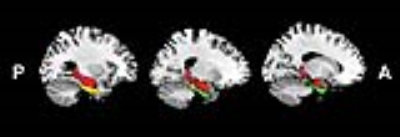 |
Effect of emotional enhancement of memory on recollection process in young adults: The influence factors and neural mechanisms
Xiaoshu Li, Haibao Wang, Xiaohu Li, Jiajia Zhu, Yong Zhang, Yongqiang Yu
This research explored how the inherent stimulus properties and amount of devoted attention influenced the emotional enhancement of memory (EEM) effect on recollection and evaluated the correlations between emotional memory/EEM and the spontaneous brain activity of hippocampus, perirhinal, and entorhinal cortex, and the correlations between emotional memory/EEM and the topological properties of three stipulated emotional memory processing networks in 59 young adults using resting-state fMRI. The EEM was elicited by incidental encoding, negative images, and positive high-arousal images. The hippocampus, perirhinal, and entorhinal cortex play distinct roles in the recollection and familiarity processes of emotional memory and the EEM effect.
|
|
2372.
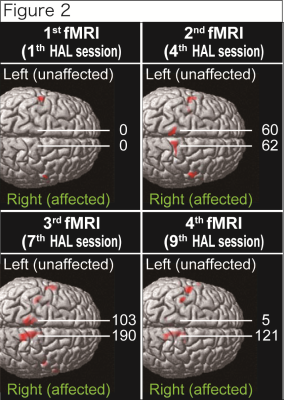 |
Brain activity during the training period of the Hybrid Assistive Limb (HAL) for a subacute stroke: an fMRI case report
Kousaku Saotome, Akira Matsushita, Aiki Marushima, Hiroaki Kawamoto, Hideo Tsurushima, Masashi Yamazaki, Akira Matsumura, Yoshiyuki Sankai
The effectiveness of hybrid assistive limb (HAL) training, which is the new rehabilitation robotic approach, for recovery of brain function after stroke remains to be clarified. This is the first report to show the brain activation alteration during the training period for HAL for subacute stroke by using motor task-based functional magnetic resonance imaging (fMRI) 4 times. Our major finding was that fMRI results demonstrated rearrangement of the cortical activation pattern in a form that induces cerebral lateralization in M1 toward the contralateral hemisphere.
|
|
2373.
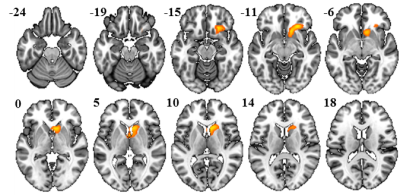 |
Neural mechanism of reward circuit in exercise addiction : an fMRI study
Kyung Eun Jang, Yang-Tae Kim, Jingu Kim, Hyunsil Cha, Heajung Choi, Eunji Kim, Moojin Yang, Jiung Yang, Huijin Song, Moon Jung Hwang, Yongmin Chang
We investigate neural activation of physical exercise related pictures in exercise addiction. Our results demonstrate that exercise addiction group showed lower activation in ventral striatum than the moderate exercise group, indicating that dopamine release of the ventral striatum in exercise addiction group may reduce because of withdrawal symptoms and negative prediction error. Moreover, we found that exercise addiction group showed less activation in the posterior orbitofrontal cortex than the other groups, suggesting that exercise addiction group may not deliberate fitness equipment and body shape of exerciser as reward value.
|
|
2374.
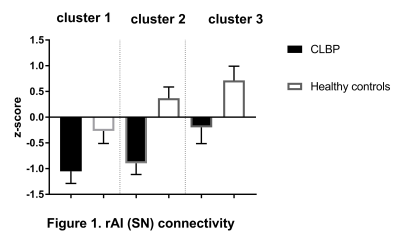 |
Functional connectivity of intrinsic brain networks in chronic low back pain
Arman Tadjibaev, William Cottam, Dorothee Auer
Understanding pathological changes in intrinsic connectivity networks may advance our knowledge of chronic pain. We performed resting state seed-based functional connectivity analysis of main intrinsic brain networks in 34 chronic low back pain patients and 34 healthy controls. Results of present study are in accordance with studies that demonstrated weaker connectivity within the default mode network and reduced anticorrelation between the default mode and salience networks in chronic pain. In addition, we have identified abnormal sensorimotor network (SMN) connectivity and more profound medial prefrontal – hippocampal connectivity dysfunction in chronic low back pain.
|
|
2375.
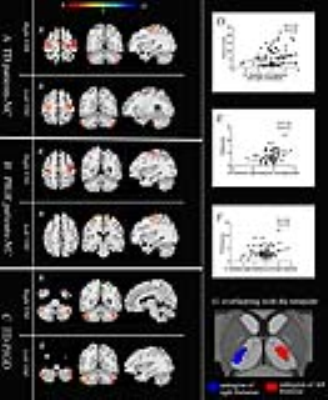 |
Ventral intermediate nucleus involved in tremor and Postural instability and gait disability-related networks in Parkinson's disease
Qiaoling Zeng, Xiaojun Guan, Tao Guo, Jason C. F. Law Yan Lun, Minming Zhang
To investigate the core pathophysiology between Parkinson's disease (PD) motor subtypes in subregions of thalamus and their different directory connectivity patterns, we collected multi-model magnetic resource imaging of 79 PD patients and 31 normal controls. We compared the grey matter volume and perfusion characteristics within the thalamus between PD phenotypes. Granger causality analysis was used to compare the effective connectivity between different subtypes. Our study revealed that core pathophysiology in tremor-dominant subtype may lie in the ventral intermediate nucleus, and a differential effective connectivity pattern existed in tremor and posture instability gait difficulty-related networks that related to behavioral heterogeneity in PD.
|
|
2376.
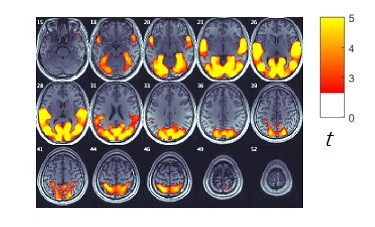 |
Perspective taking modulates inter-subject correlated hemodynamic brain responses in movie watching
Yu Ching Lam, Kuan-yi Lu, Shu-Yu Huang, Fa-hsuan Lin
We used function Magnetic Resonance Imaging (fMRI) to obtain the hemodynamic brain responses during perspective modulated naturalistic movie presentations to find the influence of perception to individual’s cognitive and affective reactions. Inter-subject correlation (ISC) was used as the analysis tool and Interpersonal Reactivity Index (IRI) was used as the behavioral measurement tool. The study applied selected group ISC analysis to distinguish neural substrates related to physical, cognitive, and affective perspective-taking using naturalistic perspective modulated movie presentation. The finding helps understanding the neural mechanism of perspective taking and would be a useful for future social cognition studies.
|
|
fMRI: Contrast Mechanisms
Traditional Poster
fMRI
Wednesday, 20 June 2018
| Exhibition Hall 2377-2389 |
13:45 - 15:45 |
|
2377.
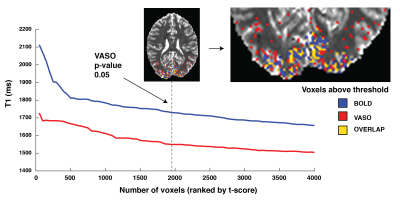 |
Hypercapnic manipulation of baseline blood volume alters coupling between BOLD and CBV visual responses
Marcello Venzi, Joseph Whittaker, Jessica Steventon, Laurentius Huber, Harald Möller, Kevin Murphy
The utility of VASO to study disease-related alterations in CBV is demonstrated. Manipulation of baseline CBV with hypercapnia mimicking arteriolar disease states produces a change in dynamic coupling of BOLD and CBV visual evoked responses. Although no significant changes in signal amplitude were detected, the expected trend for amplitude reduction was observed in the VASO signals with increasing CO2 levels. The time-to-peak of BOLD responses lengthens but CBV peak times, being longer at baseline, remain the same. This study indicates that combining VASO and BOLD contrasts can be sensitive enough to investigate the consequences of patho-physiological changes in baseline CBV.
|
|
2378.
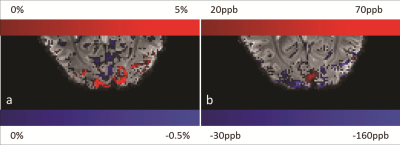 |
Quantifying Cerebral Activity during a Visual Stimuli using QSM and Multiband-EPI
Sagar Buch, Olivia Stanley, L. Martyn Klassen, Ravi Menon
Phase imaging and QSM abet the magnitude fMRI by revealing and quantifying the draining veins of the activation areas. Consequently, QSM sheds light on calibrating the % BOLD change and, when combined with CBF, has a potential to determine the basis of negative BOLD signal; in particular if it is due to increased oxygenation during rest periods or reduced oxygenation during the activation.
|
|
2379.
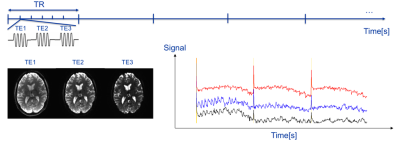 |
Simultaneous acquisition of $$$T_1$$$ Maps and BOLD fMRI Signal During Brain Activation Using Multi-Echo EPI
Xianglun Mao, J. Andrew Derbyshire, Vinai Roopchansingh, Thomas Talavage, Peter Bandettini
A quantitative $$$T_1$$$ map and blood oxygenation level-dependent (BOLD) signals are simultaneously measured during a flickering checkerboard using a multi-echo echo-planar imaging (ME-EPI) based fMRI sequence. The acquired EPI-based $$$T_1$$$ maps provide a means of tissue identification and allow direct comparison with BOLD activation maps on a voxel-wise basis, and thus offer an alternative of tissue segmentation and avoid the need for image registration between anatomical and functional imaging data
|
|
2380.
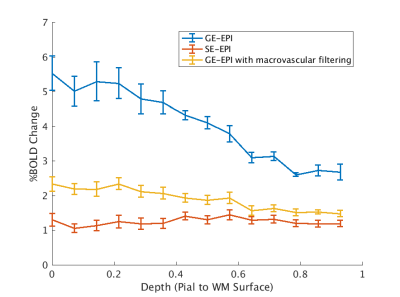 |
Comparing cortical layer activation using gradient echo with phase regression and spin echo in the human visual cortex
Olivia Stanley, Alan Kuurstra, L Klassen, Ravi Menon, Joseph Gati
High resolution fMRI sequence selection is often a compromise between specificity to tissue (SE-EPI) and sensitivity to the BOLD effect (GE-EPI). Our work compared the laminar activation profiles of SE-EPI and GE-EPI once phase regression based macrovascular filtering has been applied. We demonstrated that GE-EPI with macrovascular filtering produces a laminar profile more similar to SE-EPI than GE-EPI without filtering. This shows that GE-EPI could be used for high resolution imaging and achieve a more sensitive profile when phase regression is included.
|
|
2381.
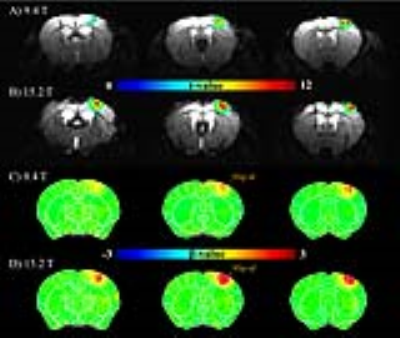 |
Field strength dependent somatosensory-evoked mouse fMRI: 9.4 T vs. 15.2 T
Won Beom Jung, Hyun-Ji Shim, Sangwoo Kim, Seong-Gi Kim
BOLD fMRI is highly sensitive to magnetic field strength. However, there is a notion that 7–9.4T is an optimal field strength for fMRI and higher fields do not increase BOLD signal changes. Here, we compared the BOLD response in the mouse somatosensory cortex at both magnetic fields of 9.4T and 15.2T to determine the BOLD dependence on magnetic field strength and found that the BOLD fMRI response is indeed increased as the field strength increases.
|
|
2382.
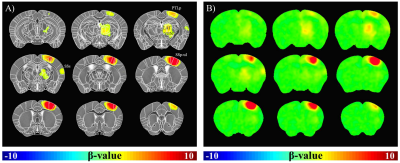 |
Mouse BOLD fMRI at 15.2 T: Detection of the entire somatosensory pathway including thalamic nuclei
Won Beom Jung, Hyun-Ji Shim, Sangwoo Kim, Seong-Gi Kim
BOLD-functional MRI is a useful tool to identify the brain function and to examine the functional effects on development, recovery, and reorganization. The most common stimulus-paradigm is the electrical forepaw/hindpaw stimulation to generate the evoked BOLD response. Although specific brain areas are involved in the somatosensory system, most studies in the anesthetized rodents have focused on the somatosensory cortex as it is difficult to detect activation in the subcortical areas. BOLD sensitivity is dependent on the field strength and affected by physiological condition under the anesthesia. Here, we demonstrated the thalamo-cortical BOLD response in mice under the ketamine-xylazine at 15.2T.
|
|
2383.
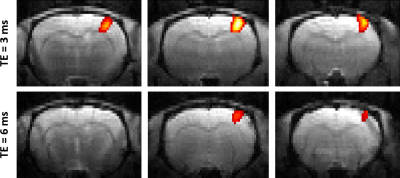 |
Sensitivity of passband bSSFP fMRI at 14 Tesla
Ileana Jelescu, Olivier Reynaud, Analina da Silva, Rolf Gruetter
Passband bSSFP is an excellent alternative to gradient-echo EPI for BOLD fMRI at high field but properties of the BOLD signal have not been reported at ultra-high field (14T). Here, we show that the BOLD amplitude is similar for short and intermediate TR (6 and 12 ms, respectively) which suggests that, in spite of the high field, BOLD contrast in passband bSSFP has limited T2* and off-band contributions, and dominant T2 contributions for TR ≤ 12 ms. A short TR can thus be used to increase temporal or spatial resolution, as well as coverage, with no penalty in intrinsic sensitivity.
|
|
2384.
 |
Optimization of Serial Correlation Correction Methods Based on Autoregressive Model in Fast fMRI
Qingfei Luo, Masaya Misaki, Beni Mulyana, Chung-Ki Wong, Jerzy Bodurka
Serial correlation (SC) of noise inflates T-statistics in simultaneous multi-slice excitation (SMS) fMRI studies with short repetition times (TR<2s). The SC can be corrected using noise pre-whitening methods based on the high-order autoregressive (AR) model. This study aims to determine the optimal order selection (OS) method of AR model to achieve the best SC correction accuracy. By evaluating the false positive characteristics in rest/null datasets, our study showed that the corrected Akaike information criterion (AICc) has the best performance among the OS criteria. We recommend use the AR model with AICc to correct the SC in SMS fMRI experiments.
|
|
2385.
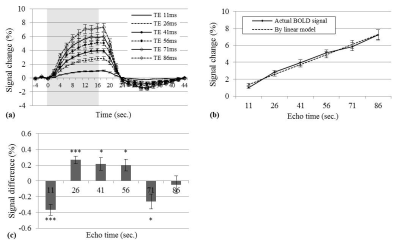 |
Estimation of physiological sources of nonlinearity in BOLD signals
Daehun Kang, Yul-Wan Sung, Satoshi Shioiri
The BOLD signals related to brain activation is often nonlinear with change in TE. In contrast to extravascular component, the nonlinearity is attributable to intravascular component due to chemical exchange between plasma and deoxy-Hb. Recently, activity-evoked pH change on the brain has been demonstrated. Since the chemical exchange is often pH-dependent, the time for the chemical exchange would change. Thus, the two-compartment model that incorporates the change would be more accurate for estimation of parameters than the model with fixed exchange time. In this study, we measured the nonlinearity by multi-echo GRE-EPI and estimated parameters of the proposed model.
|
|
2386.
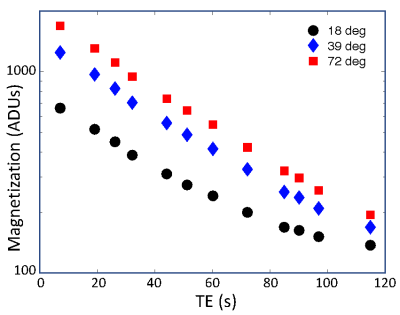 |
More than BOLD: dual spin populations create functional contrast
David Ress, Elizabeth Halfen, Vimal Singh, Amanda Taylor
The "classical" description of functional contrast postulates a single spin population with transverse lifetime modulated by neurovascular coupling. A variety of studies have cast doubt on this description. To better understand such issues, novel methods were used to probe functional contrast in the gray matter of human visual cortex as a function of echo time and flip angle. We find evidence that two spin populations with disparate lifetimes contribute to functional contrast.
|
|
2387.
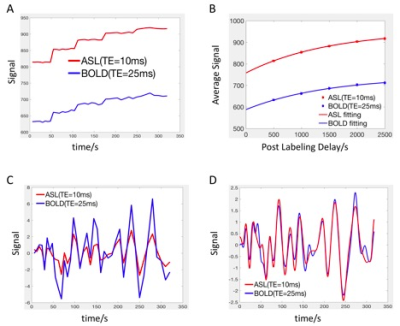 |
Exploring the Origin of the Low Frequency Oscillation Signal in dual-echo Arterial Spin Labeling MRI
Xin Shen, Ho-Ching Yang, Blaise Frederick, Danny Wang, Yunjie Tong
Arterial spin labeling (ASL), which is a non-invasive technique providing perfusion values in the unit of ml/100g/min, has been limited by low signal-to-noise ratio (SNR). Although doing average of several repeating scans might be a solution, it is essential to identify the ‘physiological noise’, i.e. low frequency oscillations (LFOs). In a study of 9 healthy subjects, the similarity and amplitude of LFOs in ASL and in blood oxygenation level dependent (BOLD) were compared to explore the origin of LFOs as well as to discover a potential method for denoising and decreasing scanning time.
|
|
2388.
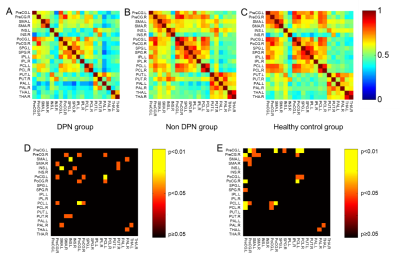 |
Reduced basal ganglia adaptability in patients with diabetic peripheral neuropathy
Yijia Zheng, Ye Wang, Geheng Yuan, Xin Qi, Rui Wang, Zhanyang Ma, Xiaohui Guo, Xiaoying Wang, Jue Zhang, Jing Fang
Diabetic peripheral neuropathy (DPN) is one of the most common complications of diabetes mellitus and the patients often have no symptoms in the early stage. Notably, basal ganglia is an important hub in the sensorimotor loop, we hypothesized that dysfunction of basal ganglia in diabetic patients with DPN. Based on this hypothesis, we assessed the function of basal ganglia in diabetic patients using resting-state functional magnetic resonance imaging (fMRI). And our results found the reduced basal ganglia adaptability in DPN patients, which is expected to providing a new perspective for the guidance of early clinical diagnosis and efficacy evaluation.
|
|
2389.
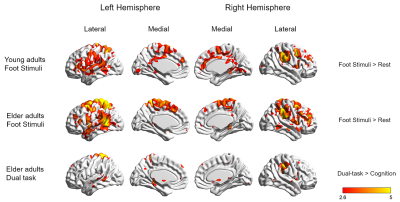 |
Why elder adults have a higher fall risk in dual-task daily life: A Preliminary fMRI Study
Yijia Zheng, Ye Wang, Yi Zhu, Xiaoying Wang, Jue Zhang, Jing Fang
Reduced plantar sensation can lead to weakened balance ability in elder adults and an addition of cognitive tasks will further weaken it. Thereby, we attempted to explore the brain activity pattern of the elder and of young adults under foot stimuli and in dual-task condition. The results revealed that elder adults have significantly stronger cortical excitability than young do, and that foot stimuli induced stronger cortical excitability compared with dual-task condition. In conclusion, these phenomena may be due to the elder adults’ inadequate central reserve. Besides, added cognitive task can further reduce the brain’s response through diminished sensory input.
|
|
fMRI: Connectivity Methods
Traditional Poster
fMRI
Wednesday, 20 June 2018
| Exhibition Hall 2390-2417 |
13:45 - 15:45 |
|
2390.
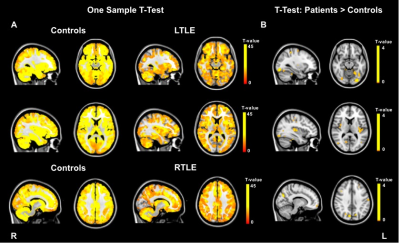 |
Investigating Local and Global Connectivity to Inform Seizure Generation in Epilepsy: a Feasibility Study
Bianca De Blasi, Ilaria Boscolo Galazzo, Marian Galovic, Enrico De Vita, Ashley Groves, Martin Tisdall, Anna Barnes, Matthias Koepp
In this work, we combined local and global functional connectivity to provide a more complete picture of the epileptogenic brain in temporal lobe epilepsy (TLE). Local functional connectivity was assessed by computing regional homogeneity (ReHo) maps which were compared between left (n=9) or right (n=10) TLE patients and controls (n=20). Areas of increased ReHo were used in a seed-to-voxel analysis to investigate global functional connectivity changes. We report a different pattern of alteration between left and right TLE patients. Left TLE patients showed a more profound bilateral increased connectivity which might highlight compensatory mechanisms.
|
|
2391.
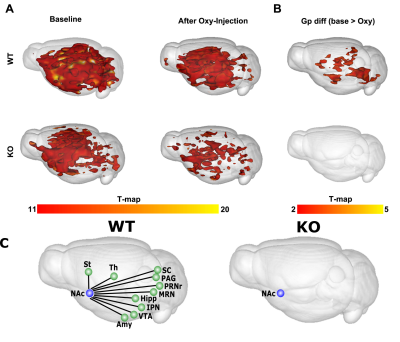 |
Oxycodone BOLD activation and connectivity signature by Mu opioid receptor in anaesthetized mice fMRI
Md Nasseef, Emmanuel Darcq, Jai Singh, Praveen Kulkarni, Brigitte Kieffer
Mu opioid receptors (MORs) mediate biological effects of oxycodone, including their analgesic and euphoric properties. To assess the effect of oxycodone on neuronal communication, we used non-invasive mouse fMRI and tested oxycodone effects in both wild-type and MOR-knockout mice in order to extract MOR-dependent effects. Analysis was performed 2 to 7 minutes after drug administration, a time where BOLD activation was minimal in knockout animals. Here, we show that oxycodone reduces functional activity of the Nucleus Accumbens seed with several brain regions, establishing a first receptor-mediated FC connectivity signature of a MOR agonist.
|
|
2392.
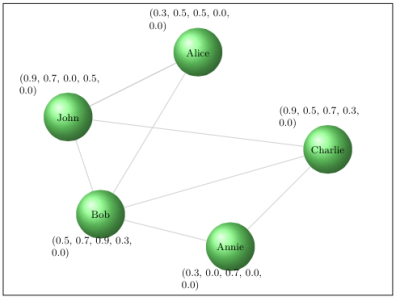 |
Using Social Network Analysis to enhance the understanding of Brain Connectivity
Claudio Tomazzoli, Silvia Francesca Storti, Ilaria Boscolo Galazzo, Matteo Cristani, Gloria Menegaz
Graph-based network modelling is becoming increasingly pervasive touching at very different fields, ranging from social networks to brain connectivity. This works is a first attempt to borrow the concept of “transtopic messaging” from social network for its exploitation in the functional connectivity framework. Basically, different functional tasks are mapped to different “semantic topics”, and the overall relevance (according to given metrics) of the nodes of the network graph in ruling the spread of the different “topics” is assessed. This rises the connectivity analysis of one level of abstraction allowing to assess the overall transtopical relevance of each node of the graph providing information on the higher-level structure of the network.
|
|
2393.
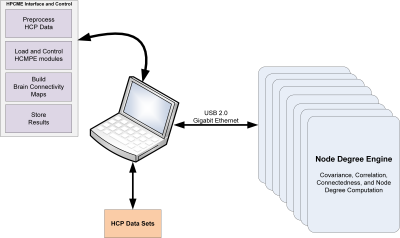 |
High-Performance Correlation and Mapping Engine for Brain Connectivity Networks from High Resolution fMRI Data
John Lusher II, Jim Ji, Joseph Orr
Seed-based Correlation Analysis (SCA) of fMRI data has been used to create brain connectivity networks. With close to a million unique voxels in a fMRI dataset, the number of calculations involved in SCA becomes high. With the emergence of the dynamic functional connectivity analysis, and the studies relying on real-time neurological feedback, the need for rapid processing methods becomes even more critical. This work aims to develop a new approach which produces high-resolution brain connectivity maps rapidly. Preliminary results show that this process can improve processing by a factor of 27 or more over that of a conventional PC workstation.
|
|
2394.
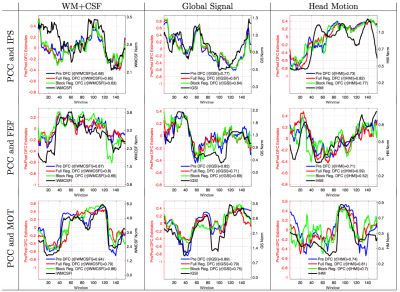 |
Regression does not Eliminate the Effects of Nuisance terms in Dynamic Functional Connectivity Estimates
Alican Nalci, Thomas Liu
Nuisance regression is commonly used in dynamic functional connectivity (DFC) studies to reduce the influence of nuisance factors, such as head motion or physiological activity. Here, we show that DFC estimates before nuisance regression are significantly correlated with the norms of various nuisance terms. Furthermore, we find that nuisance regression does not eliminate the correlations between DFC estimates and the nuisance norms.
|
|
2395.
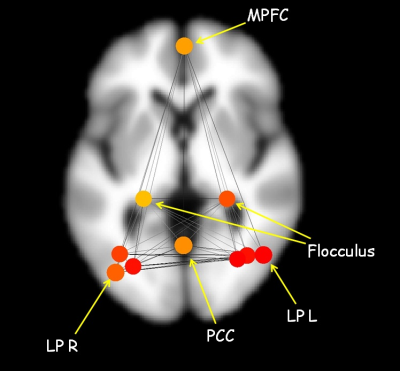 |
Malfunction of cerebellum functional connectivity in patients with mTBI. rsfMRI study.
Maxim Ublinskiy, Natalia Semenova, Petr Menshchikov, Andrei Manzhurtsev, Ilya Melnikov, Tolib Akhadov
Mild TBI appears to be a possible reason of connectivity malfunction in normal-appearing flocculus.
|
|
2396.
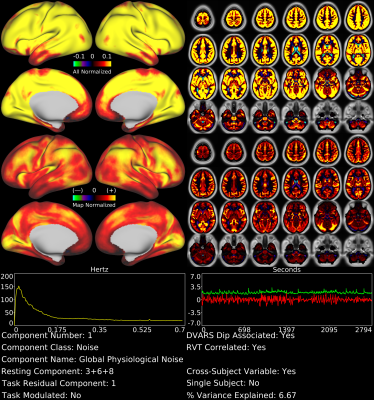 |
Using Temporal ICA to Selectively Remove Global Noise While Preserving Global Signal in Functional MRI Data
Matthew Glasser, Timothy Coalson, Janine Bijsterbosch, Samuel Harrison, Michael Harms, Alan Anticevic, David Van Essen, Stephen Smith
A major unresolved methodological issue in fMRI is how to address the problem of spatially global noise, particularly in resting state functional connectivity data. Global signal regression is effective at removing global noise, which largely arises from physiological sources; however, it has the drawback of additionally removing global or semi-global neural signal as well. Here we present a method to selectively remove global noise while preserving global neural signal using temporal ICA. Thus, we remove a global positive bias in functional connectivity without inducing the network-specific negative bias that results from global signal regression.
|
|
2397.
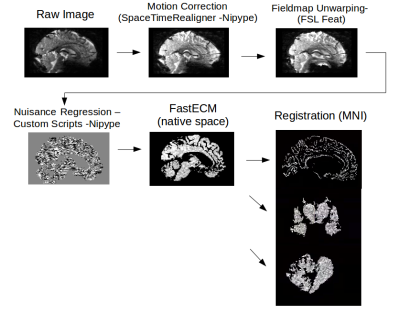 |
Preserving Maximal Spatial Specificity in Resting State Group Analysis at 7 Tesla
Anna-Thekla Schmidt, Julia Huntenburg, Christine Tardif, Claudine Gauthier, Arno Villringer, Christopher Steele, Pierre-Louis Bazin
Most studies use standard software pipelines for processing and analyzing fMRI data. These pipelines were designed to work with data from 3 Tesla scanners. With more widespread availability of ultra-high field MRI scanners, new processing techniques need to be applied to address the unique demands of high resolution data and to fully take advantage of the high spatial specificity. Here, we propose a novel approach for processing and analysing high resolution resting state fMRI data.
|
|
2398.
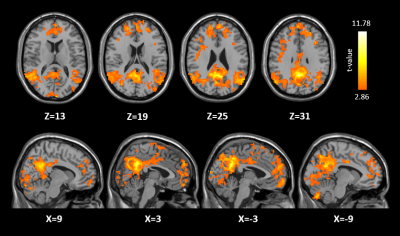 |
Detecting resting-state brain functional networks using oxygen extraction fraction contrast
Yang Yang, Yayan Yin, Qihong Zou, Yang Fan, Jia-Hong Gao
The traditional resting-state fMRI studies are based on the blood oxygenation level dependent (BOLD) contrast. Compared with BOLD, the oxygen extraction fraction (OEF) can more directly reflect the neuronal activities. However, due to the poor temporal resolution of existing OEF techniques, there is no study detecting resting-state networks with OEF contrast. In this study, the OEF contrast based resting-state networks were investigated through a newly proposed technique. Both seed-based correlation and independent component analysis were used and the results suggested that OEF can be used as an effective contrast to study resting-state brain networks.
|
|
2399.
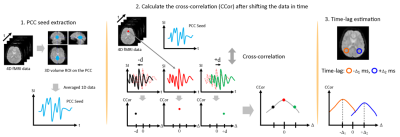 |
Estimating the time-lag of neuronal activity for the default mode network using multi-band EPI acquisitions in resting-state fMRI
Atsushi Tachibana, Yoko Ikoma, Yasuhiko Tachibana, Jeff Kershaw, Yoshiyuki Hirano, Katsutoshi Murata, Tatsuya Higashi, Takayuki Obata
Conventional EPI requires a temporal resolution of 2-3 seconds to obtain whole-brain data for resting-state fMRI (rsfMRI). More recently, multi-band EPI (MB) acquisition can be used to improve temporal resolution and obtain whole-brain coverage in less than 1 second. Our hypothesis is that MB acquisition can be used to detect the time-lag of neuronal activity. In this study, we estimated the time-lag in the default mode network using conventional (TR 2000 ms) and MB (TR 500 ms) rsfMRI. Significant time-lags between PCC and AG, and between mPFC and AG were detected only for the MB acquisition.
|
|
2400.
 |
The investigation of brain functional alterations of MCI patients by using two novel non-linear analysis techniques
Lijiang Wei, Zhe Ma, Zhizheng Zhuo, Bin Jing, Haiyun Li, Yingjie Mei
In this paper, we proposed two novel non-linear analysis methods including cross-sample entropy of ordinal pattern and inner composition alignment (IOTA) of ordinal pattern to construct brain network based on functional magnetic resonance imaging. Group-level statistical comparisons were performed to investigate the differences of brain networks. The results showed that the network related to hippocampus, amygdala and posterior cingulate cortexin in mild cognitive impairment (MCI) participants significantly differ from in normal controls. Our results suggest that both the non-linear methods can be applied to estimate the characteristics of brain network in MCI.
|
|
2401.
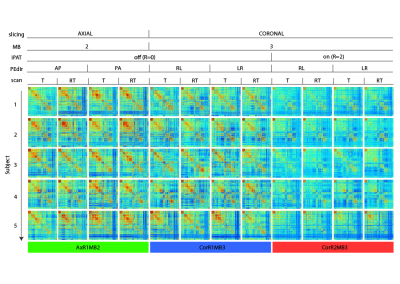 |
Functional connectivity sensitivity to image acceleration and orientation in simultaneous PET/MRI
Alessandro Palombit, Marco Castellaro, Erica Silvestri, Enrico De Vita, Diego Cecchin, Alessandra Bertoldo
Resting state fMRI (rs-fMRI) permits in-vivo characterization of brain’s functional connectivity (FC). Multi-Band accelerated EPI allows to improve the temporal resolution of rs-fMRI data and, potentially, to achieve a better characterization of the brain network correlations. However, the impact of image acceleration and orientation on FC structure has not been quantified. In this work we investigated FC changes related to image acceleration effects in a test/retest rs-fMRI protocol. We found FC differences involving relevant networks, confirmed even by graph analysis of the FC maps. Our findings explore the lower bound of single-subject FC reliability and network-dependent acceleration sensitivity.
|
|
2402.
 |
Multiband-enabled Resting State Functional Connectivity Mapping in Simultaneous PET/MRI
Alessandro Palombit, Erica Silvestri, Marco Castellaro, Enrico De Vita, Diego Cecchin, Alessandra Bertoldo
PET/MRI scanner is the ideal instrument to simultaneously study brain’s metabolism and fMRI-based functional connectivity (FC). State-of-the-art fMRI multiband (MB) EPI sequences on those scanners can be limited by the PET-transparent head coil receiver capabilities as the longitudinal coil elements organisation along head-feet direction is theoretically unable to provide sensitivity variation along this axis. In this work we provided optimal sequence settings for FC studies encompassing available out-of-plane (MB) and in-plane (iPAT) accelerations with two slice orientations demonstrating MB-EPI reliability for FC studies and how non conventional slice orientations can enhance supported MB acceleration factors.
|
|
2403.
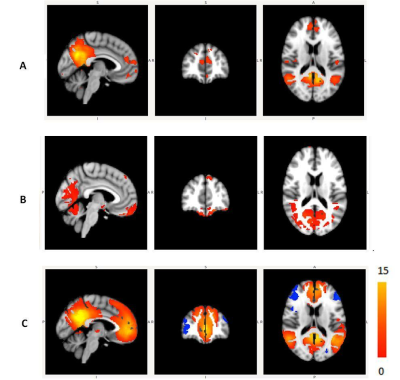 |
Hemodynamic reorganization approach to estimate the functional connectivity in task based functional MRI study
Swati Agrawal, Vijayakumar C, Ardaman Kaur, Subash Khushu, Rinku Sharma, Suresh Sharma
Modulations in brain connectivity by task reveal more insights into complex interaction and neuronal communication occurs between various cortexes. However, assessment of these modulation is limited by dynamic hemodynamic (HRF) spread (3 to 6 sec) occurs at every brain regions by various task stimulus. This dynamic HRF limits methods of resting-state studies to be adopted directly in task-fMRI. Thus, in this study, a novel hemodynamic reorganization method is proposed to rearrange the dynamic HRF of every stimulus such that functional connectivity modulation caused by every stimulus and their mutual correlations in visual search based target detection task can be assessed.
|
|
2404.
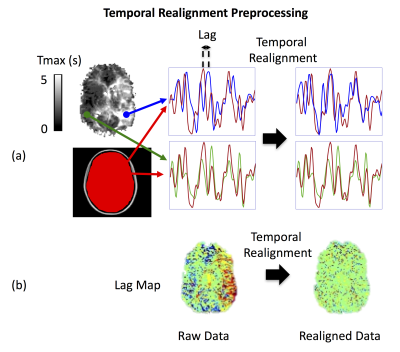 |
Correcting for erroneous assessment of resting-state functional connectivity caused by prolonged arterial arrival time: a study in Moyamoya patients
Hesamoddin Jahanian, Thomas Christen, Michael Moseley, Greg Zaharchuk
We studied the default mode network in a group of Moyamoya patients using ICA method and observed erroneous assessments of functional connectivity in regions with prolonged arterial arrival time. We showed that these arterial delays could lead to erroneous elimination of affected brain regions from a functional connectivity network. We proposed a method called “temporal realignment” to mitigate this problem.
|
|
2405.
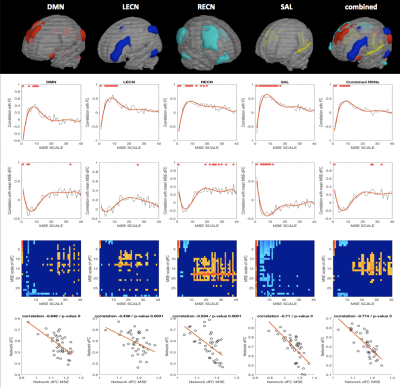 |
Functional Connectivity within the Cognitive Networks is associated with the Complexity of Network Node Dynamics
Kay Jann, Danny Wang
While static and dynamic functional connectivity (sFC/ dynFC) provide estimates of the integrity and information transfer between brain network nodes, the signal dynamics at each node represents the local information processing. Here we assessed the relation between static FC, dynFC and complexity of signal fluctuations wishing nodes within four networks. We found that more complex and thus less predictable signal in networks allows for a more dynamic functional connectivity and hence a richer repertoire of different FC states.
|
|
2406.
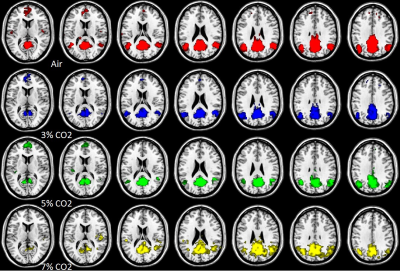 |
Alterations of Resting State fMRI Functional Connectivity in Hypercapnia
Yu-Chia Cheng, Teng-Chieh Cheng, Wen-Chau Wu, Teng-Yi Huang, Chao-Chun Lin, Chia-Wei Lin, Wu-Chung Shen, Yi-Jui Liu
The purpose of this study is to explore the alterations of brain functional connectivity among different hypercapnia using resting-state functional magnetic resonance imaging (rs-fMRI). 10 healthy males were enrolled in this study. A high-resolution T1WI image and BOLD-EPI were performed by a 3 Tesla MR scanner. The CO2 gas mixture (air, 3%, 5% and 7%) was given at the different hypercanpic for each experiment. Our results show that the brain functional connectivity in resting state is changed in hypercapnia. FC is gradual reduction as the increased CO2 fraction in the most primary functional networks, expect the executive control network.
|
|
2407.
 |
Adaptive global signal regression for resting-state functional connectivity MRI
Narges Moradi, Mehdy Dousty, Roberto Sotero
One of the primary steps in exploring resting-state functional connectivity MRI is to identify and remove the global signal (GS). Plenty of methods have been proposed for this. However, the majority of them are based on an averaging approach known to produce spurious connectivity values. In this work, we used a nonlinear adaptive method to construct voxel-specific GS. The method is tested for task-positive, task-negative and reference ROIs by computing the Pearson correlation coefficient. Our results show a high level of precision for the proposed approach, while the conventional method could not provide an accurate brain functional mapping.
|
|
2408.
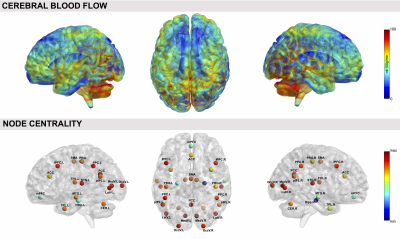 |
Probing functional connectivity and network modelling from perfusion neuroimaging with Arterial Spin Labeling
Ilaria Boscolo Galazzo, Silvia Francesca Storti, Francesca Benedetta Pizzini, Enrico De Vita, Claudio Tomazzoli, Anna Barnes, Francesco Fraioli, Gloria Menegaz
Nowadays, the assessment of brain functional connectivity (FC) patterns, ranging from resting-state networks to network modelling, can rely on Arterial Spin Labeling (ASL) MRI as an alternative to the gold-standard sequence represented by the blood-oxygenation-level-dependent contrast. We evaluated FC mapping from different perspectives (experimental protocols, populations and analysis methods), trying to overcome some of the present challenges related to the ASL applicability in this framework. The results demonstrate how FC patterns and changes can be reliably detected using ASL, with the added value of allowing the simultaneous quantification of brain perfusion, a direct marker of neuronal activity.
|
|
2409.
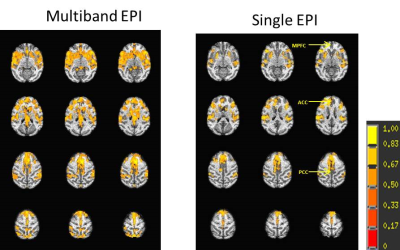 |
Improving the resting state fMRI detection in anesthetized monkeys using multiband MRI technique
Chun-Xia Li, Doty Kempf, Leonard Howell, Xiaodong Zhang
Neuroimaging studies of non-human primates are generally conducted with anesthesia using anesthetics like isoflurane which is known to suppress the neuronal activation of the brain substantially. The resting state functional MRI (rsfMRI) examination in anesthetized monkeys is hindered by limited choices of anesthetics compared to rodent studies. In the present study, multiband MRI technique was explored to improve the rsfMRI detection in anesthetized macaque monkeys. The preliminary results suggest the multiband MRI can be employed to dramatically improve the rsfMRI detection in examining the functional connectivity of default mode network in anesthetized monkeys using a clinical 3T setting.
|
|
2410.
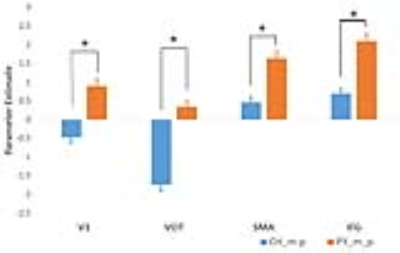 |
Effective connectivity of brain regions involved in word processing: an fMRI study of Chinese character and pinyin in reading
Guoyuan Yang, Jianqiao Ge, Jia-Hong Gao
Reading words has been thought to be consist of three underlying constituents including orthographic, phonological, and semantic processing. The relationship between orthographic, phonological, and semantic processing in nonalphabetic language were still unclear. In the present study, we used functional magnetic resonance imaging (fMRI) to scan subjects when they were reading Chinese character and pinyin. Using dynamic causal modeling, we found that Chinese character reading processing was apparently involved ventral stream, and Chinese pinyin reading significantly involved dorsal stream. We conclude that nonalphabetic language with logographic system like Chinese character may needs less assembling phonology when word processing.
|
|
2411.
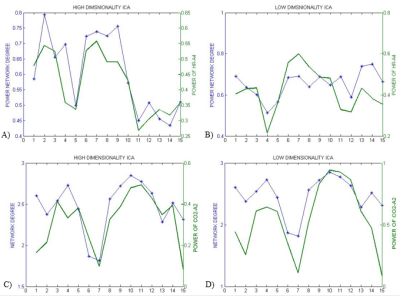 |
Investigation of Physiological Variability Effects on fMRI Dynamic Functional Connectivity using Independent Component Analysis
Foivia Nikolaou, Christina Orphanidou, Kevin Murphy, Richard Wise, Georgios Mitsis
The BOLD fMRI signal is influenced not only by neuronal activity but also by fluctuations in physiological signals. It has been shown that estimates of resting dynamic functional connectivity (DFC) may be confounded by the effects of physiological signal fluctuations. Here we examine the relation between DFC patterns for the DMN, visual and somatosensory networks and the time-varying properties of simultaneously recorded end-tidal CO2 and HR signals by using resting-state fMRI data and several variants of ICA. A modulatory effect, which was more pronounced in specific frequency bands, of the physiological signals on the resting DFC patterns is revealed.
|
|
2412.
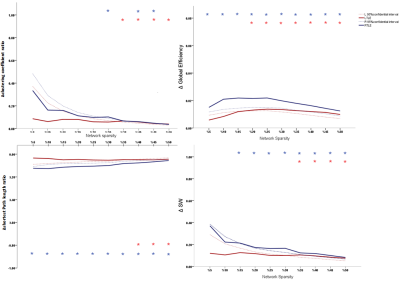 |
Using graph theory measurements acquired from resting state fMRI data combine with machine learning methods to investigate abnormalities in temporal lobe epilepsy and classification.
Mohsen Mazrooyisebdani, Veena A. Nair, Bruce Hermann, Beth Meyerand, Vivek Prabhakaran, Raheel Ahmed
Many studies has shown structural damage in TLE caused by seizure propagation. We use graph theoretical approach to look at network differences in TLE's brain in order to find abnormalities that may cause seizure. We find out that subcortical regions such as thalamus and hippocampus are abnormally more connected together and with cerebellar regions and these regions are generally less involved in transferring information to other part of the brain from graph theoretical respect of view. In other word, any information pulse that generated in these regions, will circulate faster within these regions which might be the reason for seizure.
|
|
2413.
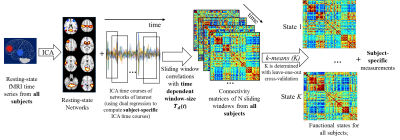 |
Optimal Time-Dependent Window-Size Reveals a More Accurate Picture of Dynamic Functional Connectivity
Xiaowei Zhuang, Zhengshi Yang, Brent Bluett, Sarah Banks, Dietmar Cordes
We have introduced a new method to determine the optimal time-dependent window-size for calculating sliding-window correlations between two non-stationary time series. The time-dependent window-size is calculated from the local information of intrinsic mode functions of each time series computed using empirical mode decomposition. Results from simulation demonstrate that the running-correlation computed with a time-dependent window-size is able to capture local transients without creating unstable fluctuations. By incorporating the optimal window-size in a whole-brain dynamic functional connectivity analysis, we are able to view differences in whole-brain temporal dynamics between normal control subjects and PD subjects more precisely.
|
|
2414.
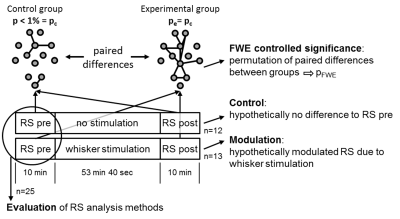 |
A new analysis of resting state connectivity and graph theory reveals distinctive short-term modulations due to whisker stimulations in rats.
Silke Kreitz, Benito de Celis Alonso, Michael Uder, Andreas Hess
In this study we introduced a powerful new method to analyze resting state functional connectivity. The MSRA approach integrates classical seed based correlation and modern graph-theory. In comparison to two undirected graph-theoretical approaches, it resembles ICA components best and is characterized by its high specificity and reproducibility. In combination with an adaptation of the network based statistics to paired samples, it promises to be a powerful tool to investigate short term modulations of sensory stimuli related resting state connectivity and ultimately impact our understanding of basic brain functions like fear to higher functions such as plasticity, learning and memory.
|
|
2415.
 |
Cross State Interference in Dynamic Functional Connectivity
Victor Vergara, Vince Calhoun
Several parameters need to be set in a dynamic connectivity analysis. The window length (time interval used to estimate windowed correlation) gained recent attention after simulated data showed that a minimum length should be observed. This work presents evidence that large window lengths are not free of nuisances and proposes a method to find an appropriate window length. The proposed length is found to be half the average duration of a dynamic connectivity state. Longer window lengths produces cross-talk interference among states.
|
|
2416.
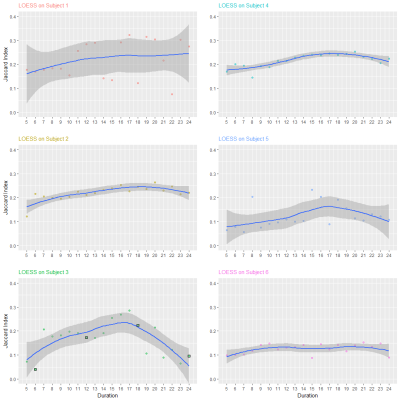 |
Resting State ASL : Toward an optimal sequence duration
Corentin Vallée, Pierre Maurel, Isabelle Corouge, Christian Barillot
Resting-state functional Arterial Spin Labeling (rs-fASL) in clinical daily practice and academic research stay discreet compared to resting-state BOLD. However, by giving direct access to cerebral blood flow maps, rs-fASL leads to significant clinical subject scaled application as CBF can be considered as a biomarker in common neuropathology. Our work here focuses on the link between overall quality of rs-fASL and duration of acquisition. To this end, we consider subject self-Default Mode Network (DMN), and assess DMN quality depletion compared to a gold standard DMN depending on the duration of acquisition.
|
|
2417.
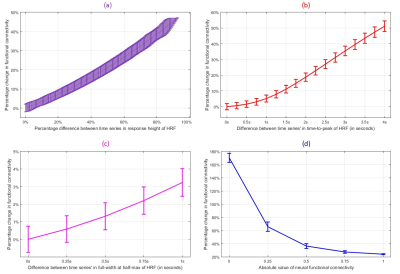 |
Resting-state fMRI functional connectivity is confounded by the hemodynamic response function (HRF)
Rangaprakash Deshpande, Guo-Rong Wu, Daniele Marinazzo, Xiaoping Hu, Gopikrishna Deshpande
Functional MRI is an indirect measure of neural activity, as it is the convolution of the hemodynamic-response function (HRF) and latent neural response. Recent studies show variability in HRF across brain regions and individuals, with the potential to confound resting-state functional connectivity (FC) if HRF variability were ignored. Using resting-state fMRI obtained at 7T (N=47), we estimated HRF parameters using deconvolution, and tested the hypothesis that HRF variability confounds FC. We found evidence, with simulations (up to 50% error in FC) and experimental data (mean/median error = 30.5/11.5% in FC) quantifying the impact the HRF variability on FC.
|
|
| Back |
| The International Society for Magnetic Resonance in Medicine is accredited by the Accreditation Council for Continuing Medical Education to provide continuing medical education for physicians. |
























































































































